#Fabrics Industry Analysis
Explore tagged Tumblr posts
Text
The Growth Potential of the Fabric Conditioner Market in the Dominant Region of Asia Pacific

Introduction:
The global fabric conditioner market in the Asia Pacific region has been experiencing significant growth over the past few years, driven by various factors such as increasing disposable income, changing lifestyle patterns, and a growing emphasis on personal grooming and hygiene.
As a result, the demand for fabric conditioners in the region has surged, making it a key market for industry players to explore and invest in.
In this article, we will delve into the dynamics of the fabric conditioner market in the Asia Pacific region, uncovering the factors driving its growth and the opportunities it presents for businesses.
Download Free Sample: https://www.nextmsc.com/fabric-conditioner-market/request-sample
Market Overview:
The Asia Pacific fabric conditioner market has witnessed remarkable growth, owing to the rising awareness about fabric care and the increasing adoption of fabric conditioners in households across the region.
Countries such as China, India, Japan, South Korea, and Indonesia have emerged as key contributors to the growth of the fabric conditioner market in Asia Pacific.
The market has been further fueled by the growing urban population, rapid urbanization, and the expanding middle-class demographic, which has led to a surge in demand for premium and high-quality fabric care products.
Factors Driving Growth:
One of the primary factors driving the growth of the fabric conditioner market in Asia Pacific is the increasing focus on fabric care and hygiene. With consumers becoming more conscious about the maintenance and longevity of their clothing and textiles, the demand for fabric conditioners has witnessed a steady rise. Additionally, the influence of western lifestyle trends, coupled with the desire for soft, fragrant, and well-maintained fabrics, has further propelled the uptake of fabric conditioners in the region.
Moreover, the escalating disposable income levels in many countries across Asia Pacific have empowered consumers to invest in premium fabric care products, thereby driving the demand for high-quality fabric conditioners. The shift towards convenience-oriented lifestyles has also prompted consumers to seek time-saving and effective solutions for fabric care, leading to an increased preference for fabric conditioners that offer superior softness, fragrance, and anti-static properties.
Inquire Before Buying: https://www.nextmsc.com/fabric-conditioner-market/inquire-before-buying
Market Opportunities:
The fabric conditioner market in the Asia Pacific region presents a plethora of opportunities for industry players and investors. The rapidly expanding urban population, coupled with the increasing penetration of modern retail channels, has created a conducive environment for the growth of the fabric conditioner market.
As consumers become more discerning about their fabric care needs, there is a growing demand for innovative and specialized fabric conditioner products that cater to specific fabric types, fragrances, and functionalities.
Furthermore, the evolving consumer preferences and the growing awareness about sustainable and eco-friendly products have opened doors for the development of environmentally conscious fabric conditioners in the Asia Pacific region.
With a focus on natural ingredients, biodegradability, and reduced environmental impact, there is a growing opportunity for companies to introduce eco-friendly fabric conditioners that resonate with the environmentally conscious consumer base in the region.
Dominant Players and Strategies:
In the highly competitive fabric conditioner market in Asia Pacific, several key players have established a strong presence and are continuously striving to innovate and capture a larger market share. Companies such as Procter & Gamble, Unilever, Colgate-Palmolive, and Reckitt Benckiser have been at the forefront of driving innovation and marketing strategies to capitalize on the burgeoning demand for fabric conditioners in the region.
These industry leaders have been focusing on product diversification, strategic partnerships, and aggressive marketing campaigns to expand their market reach and cater to the diverse preferences of consumers in the Asia Pacific region. Additionally, investments in research and development to create advanced formulations, appealing fragrances, and multifunctional fabric conditioners have been instrumental in gaining a competitive edge in the market.
Challenges and Future Outlook:
Despite the promising growth prospects, the fabric conditioner market in Asia Pacific is not without its challenges. Factors such as price sensitivity, intense competition, and the need for extensive distribution networks pose challenges for both existing and new entrants in the market. Moreover, the evolving regulatory landscape and the need to comply with stringent quality standards present hurdles for companies operating in the fabric conditioner market.
Looking ahead, the future outlook for the fabric conditioner market in the Asia Pacific region remains optimistic, driven by continuous urbanization, increasing consumer awareness, and the growing demand for premium fabric care solutions.
With a focus on product innovation, sustainability, and customized offerings, the fabric conditioner market is poised to witness sustained growth, making it an attractive investment destination for businesses seeking to capitalize on the burgeoning demand for fabric care products in the Asia Pacific region.
Conclusion:
The fabric conditioner market in the dominant region of Asia Pacific presents a compelling growth narrative, underpinned by evolving consumer preferences, urbanization, and the pursuit of fabric care solutions that offer convenience, efficacy, and sensory appeal.
As industry players navigate this dynamic market landscape, the opportunities for innovation, differentiation, and market expansion are abundant, offering a promising future for the fabric conditioner market in the Asia Pacific region.
#fabric conditioner market#fabric softener#market trends#industry analysis#consumer goods industry#consumer trends#household products
0 notes
Text
Flameproofing Futures: Navigating the Fire-Resistant Fabrics Market Landscape
The global fire-resistant fabrics market is witnessing growth and is projected to reach USD 5.9 billion by 2030. This growth can be credited to the increase in the demand for such materials from the chemical, oil & gas, and construction sectors. Credited to the severe guidelines for workplace safety in advanced countries. On the basis of type, the industry is divided into treated and inherent…

View On WordPress
#automotive interiors#Competitive Landscape#Fire Hazards Prevention#Fire-Resistant Fabrics Market#Flame-Resistant Materials#Home Furnishings#Industrial Safety#Investors#manufacturers#market analysis#Market Segments#opportunities#Protective Clothing#Regional Influences#Safety Industry#Textile Innovation
0 notes
Text
The Business Research Company offers fabric filters market research report 2023 with industry size, share, segments and market growth
#fabric filters market size#fabric filters market share#fabric filters market report#fabric filters market growth#fabric filters market#fabric filters industry#fabric filters market data#fabric filters market research#fabric filters market demand#fabric filters market insights#fabric filters market overview#fabric filters market forecast#fabric filters market analysis#fabric filters market trends#global fabric filters market#fabric filters market segments
0 notes
Text
Handle With Care - Aaron Hotchner x Reader




Summary: Reader and Aaron meet for the first time before she starts as a full-time nanny for Jack.
Notes: Hopefully will be at least 5 parts! I'm excited to be writing again :)
Word Count: 4.6K

I always believed in new beginnings, but as I stood on Aaron’s doorstep, rolling a suitcase in one hand and a Vera Bradley duffel bag in the other, I was tempted to question my resolute thinking. It had yet to fail me. Not when I was hardly eighteen and living on the other side of the country, vying for my spot at the esteemed culinary arts program. And not when I’m twenty-four with a stint as the private chef
Professional chef turned nanny–for my father’s beloved mentee, no less. My parents, ever supportive and ever loving, practically held an intervention when I showed up on their suburban door step a fractured shell of the bubbly daughter they dropped off at the airport.
Five years later, I’m sleeping in the same bed. I had nightmares about leaving once again. And yesterday I gave up that bed for a full-time position as Aaron Hotchner’s live-in nanny. Aaron, who I never even met, is my father’s protege. He knew him as a whip-smart, young lawyer from a family Law dynasty at Quantico. My father took him under his wing and even after his early retirement from the BAU they would get together for an annual work lunch.
I was nearly finished with my final year of the Los Angeles Culinary Arts Program when my fathers called to say that Aaron’s wife was murdered. I remembered thinking how lucky Dad was and how brave Daddy had to be. With one day off saving the world and the other left to hold down the fort with an awfully anxious only child daughter.
One year later, I was unemployed and completely blacklisted from the culinary entertainment industry for reasons beyond my control and without my fault. I gripped the suitcase, my chipped fingernails so jagged they punctured my skin.
Aaron had a nice house with a manicured front lawn, a big wrap around porch, and a fully furnished backyard. Clearly, he was a man with a lot of education and a lot of smarts to top it off. He worked hard. It showed, these neighborhoods of Arlington, Virginia weren’t cheap. No wonder my dads were dying to relocate to Georgia.
The door swung open before I could work up the courage to ring the bell or knock on the dark cherry wood. Aaron answered. He wore a dark green men’s quarter zip that was pushed up, showing off his forearms. His dark, charcoal gray watch shone as he let me into his foyer.
He had a foyer.
And a house that smelt like warm cinnamon and musk.
“Y/N,” Aaron said, nodding to me with a smile, “Please give me your bags. And we’ll go sit and chat before Jack comes. His grandma is still in town and brought him to the zoo.”
I complied. There wasn’t a need for me to protest. And clearly, by the looks of those forearms, he would have no problem handling my bags. I only brought a single suitcase, a duffel, and five boxes of books. Aaron’s mother-in-law, Lorriane, had been staying with them since Haley died a year and a half ago. But her husband broke his hip. Apparently, Aaron had added a mother-in-law suite for Lorriane and judging by the looks of his home, the suite I’d be living in for the foreseeable future was twice the size of my studio in LA.
“Thanks.” I said, grabbing a seat on the brown fabric sofa, “My dad said I had to say hello to you for him. He still raves about you. Like all the time.” I chuckle, watching as Aaron hands me a glass of iced tea.
“Marty’s a good man. He and Gideon built the Behavioral Analysis Unit. Our team is in constant debt to him.” Aaron spoke so formally, gesturing for enthusiasm with his hands.
“Yeah, well. He’s always just been dad to me.” I smiled, the man I knew showed up to my field hockey games even if it meant holding office hours there. He was the most there dad I could ask for– maybe it was neck in neck for the both of them.
“So Jack?” I said, breaking the silence. “How–how’s he been?” I couldn’t help but wonder. My dads had a close friend who helped them with their surrogacy journey, so while I didn’t have a mother in the traditional sense, the woman who I’ m half of was still alive and in my life. Debra was more like an aunt to me, fun and spirited and eternally youthful. But I still had her.
Unlike Jack, who’s Earthly ties to his mother were shredded in an horribly violent way.
My dad hardly ever cried, but when he called and told me that Aaron’s wife died I could hear it in his raw voice. Aaron’s a man cut from the same cloth a Dad; stoic and responsible. He was a wall of somber trepidation, but somewhere deep inside I could make out the man that wasn’t cataclysmically destroyed.
“Jack is…he’s a strong kid. I put him in therapy after it happened. He still goes once a week. Laura, she’s his therapist. She’s wonderful. Truly has helped Jack work through all this.”
“That’s good. That’s really good, Mr. Hotchner. It seems as though Jack has a solid foundation here.” I say, unsure what to say exactly. I can make an omelet six different ways, yet it’s lost on me to know what to say to a widower with a little boy. If I had to bear even a fraction of their grief, I’m sure it would break me. I would crumble. But these two boys? They’re a good man in the storm. And I know in my bones, it’s entirely Aaron’s doing. If that man is anything, he’s steady.
“It’s Aaron. Please, Mr. Hotchner reminds me of my father.” He cringes, the lines on his eyes creasing, “Your dad said you’re a professionally trained chef? Unfortunately, Jack’s still squarely in the dinosaur shaped chicken nugget and baked tater tots phase. It’s been a struggle to get him to try anything new…for…for awhile now, if I’m being honest.”
I nod, thinking that Jack’s food discouragement might stem from losing his mom. “Well, the way I see it, Jack lost his mom at how old? Four and half? That’s when we’re starting to really know what we like and don’t like to eat. His life was turned upside down and shaken all around when you lost her. So maybe he needed some consistency in a world of chaos. Not that your home is chaotic, it’s lovely and clean and happy. It’s just…loss…”
“Losing your mother as a toddler really fucks up your life.” Aaron says. He speaks so definitely, as if he means everything so ardently you could cast it into stone.
“Yeah.” I add, somberly. “But I think we can get him to branch out. Make it a game. I’d love to cook with him. I can get him kid-safe tools so he can be involved in food preparation and cooking. Oh! Maybe Jack and I can have a garden. I’m sure that will get him eating vegetables and fruits.”
Aaron’s neutral expression slowly transitions to a soft smile. He thumps his fingers on the wooden table, as he looks out through the deck. I could feel him glance back at me and then to the yard again.
“I think that a garden would be lovely over on the side. It’s far enough away from the pool and patio.” Aaron offers, sipping his tea. It’s sweet tea, too sweet for me. Working in kitchens throughout my program has trained me to not only tolerate black coffee, but to actively seek it out. He smiles, his grin defining his face. “Good idea.”
I feel heat at his praise. I like doing well, who doesn't? But after a series of mishaps and bad luck, an 'atta' girl is my Hail Mary of the month. I simply nod. “Simple things to start so he can see some quick results. I’ll get him super involved in it. Make him feel like he’s a part of a team.”
“I work a lot. My team flies across the nation, as you know. It takes me away from here for days on end. It was getting too much for Lorriane. And how her husband broke his hip.” Aaron shakes his head, “Honestly, you couldn’t have shown up here at a better time.”
He runs his pointer finger over the water rung pooled on the coasters. “Jack’s a very easy kid. Reasonable. But shy. He was shy even before Haley…even before last year. I’ve brought him to the pediatrician because he stopped talking for a while, but she said that we’ve all survived an immense trauma and our brains simply process and live through that trauma differently.”
Sitting there, I couldn’t help but think how lucky this little boy is. His dad was running up the hill; pushing that boulder up and up and up for an eternity. It must be an awfully lot to carry, without anyone to share the load.
“Yeah. I’m sure it is? Is he going into Kindergarten after the summer?” I ask, wondering if Jack went to Kindergarten on time or if Aaron and his grandma kept him home when they lost Haley.
“Lori, Haley’s mother, taught preschool for thirty-five years. She told me to keep him home for a year, let him be a little bit older and get the help he needs to heal and then send him. So I listened. I think that was one of the only decisions I made as a team this year.”
Sympathy must have colored my face because Aaron’s demeanor shifted quickly. He sat up, sipping his iced tea and wiping his hands on his jeans. “So basically your weekdays are around 8am-7:30pm. And occasionally on the weekends when the team does have to be on location But recently, I’ve been trying to transition to a more leadership position at headquarters. Hopefully, that’ll mean less traveling.”
I quickly journaled the hours down in my notebook. Live-in nannying hours are not for those looking for a job to allow them the life of leisure. Naturally that couldn’t possibly be true for a position whose main coworker is a five and a half year old boy.
“Alright. So that’s summer hours. We’ll need to brainstorm lots of stuff to do all day. Maybe the library?” I write a small note to get ideas and have them approved by Aaron.
He nodded, “Yes, summer hours are a lot, but Jack will be going to a couple camps that his therapist recommended. So you can get a couple hours each day to yourself. I am ready to compensate accordingly. Between my new role at the BAU and other personal investments, we live comfortably. How’s $2,500 to start and then we’ll discuss a raise in the future. And naturally your room and anything you may want to eat or have will be covered by me.” Aaron says it again in a way that leaves no room for argument. He must’ve been a great lawyer; no wonder dad adores him.
“That’s quite a lot of money.” I’m shocked and my face does a horrible job of hiding it. “I’m not a professional nanny. I’m good with kids. Really good. But I don’t do this for a living. This is you doing me a favor because if it wasn’t for you, I’d be a waitress at my dads’ country clubs” I cringed, my mind instantly filtering in an image of me serving one-time sorority sisters bottomless mimosas for an Easter Brunch.
“I apologize if you though that it was up for discussion, Y/N. Your first month’s pay will be $2,500 each week. And then it will increase to $3,250 each week. If I’m asking you to work 13 hour days plus one weekend a month? I better be paying you that much. And you’re still on Marty’s health insurance?”
I rolled my eyes, of course dad mentioned that to Aaron and of course Aaron double checked. Aaron just might have Marty, JD beat when it comes to thoroughness. “Yeah, till I’m 26. And that’s like…a year and change away.” I say, implying that it’s not up to me, or Aaron even, to know how long I’ll be with him. I wasn’t sure if I would ever venture out to LA again; not after what happened that sent me back here for good.
But the thing about food is that everyone wants good food, no matter where they live. And right now, the ones that wanted something good in their lives, lived in a lovely Colonial home on Moss Avenue.
“I guess there’s no arguing with you, prosecutor.” I say, my voice increasing just so that it balances the line between teasing and something else…something else I should be too ashamed to admit.
It elicited a smile from him and all of the sudden it was completely worth it. Aaron finishes his tea, and places it into the sink after dumping the remaining ice chips down the drain.
“Non-negotiable. It’s in your contract. Along with a health insurance package should you need to go off Marty’s name. Plus all that tax information that I’ll get you someone to walk you through it.” Aaron explained.
“Thank you.” I replied, grateful that it was both all above the table and that I would be given the resources to help me figure it out. Looking at the pile of paperwork in my lap, I was sure that if Aaron didn’t offer legal literacy assistance I would be way in over my head. “That’s wonderful. Really.”
“I just…I just want my son to be a good kid with a good childhood. That’s all. I want to be there for him and if I’m not there, I want the next best thing there. You know?” Aaron said and I’m not sure if it’s a plea or statement. Or if it was stuck somewhere in the middle; lost at sea like Aaron was himself. An island unto himself, drifting as the tide rolled in.
I break the silence. “What was Haley’s favorite meal?”
Aaron smiled. His eyes, crinkling again. “She had chicken piccata on our first date. And we ate it at our wedding. And when she found out she was pregnant with Jack she made it for me.” I nodded, understanding the important link between food and memories.
“Let’s make it. For Jack and you and Lorianne to share tonight before she leaves. It’s going to be a big transition for him to go from having grandma all the time to me, someone very new.” I expressed, hoping that I didn’t sound bossy or as if I wanted to parent Jack myself.
“That’s a lovely idea, Y/N.” Aaron sighed. “But I never was much of a chef. I wouldn’t know the first place to start.”
He leaned his hands against the table, a slight smile breaking the formidable since that had fallen between us in the moments before. I smiled back, standing from the table to reach my tote bag.
I pulled out an apron, the kind that criss crossed over my back. It was denim blue with a canvas front and large pockets.
“Move over,” I said, tying my apron, “It might be your kitchen, Aaron, but for tonight you’re kicked out”

The chicken ended up being more chicken piccata adjacent than a true representation of the dish. I mixed a seasoned blend of flour and spices for the dredging. Then, butterflied and pounded the chicken breasts into thin pieces.
Aaron’s kitchen was spacious and airy. There was a large island with barstools on one side and lots of pantry and cupboard space on the other. I stood at the island, dredging the chicken in seasoned flour before placing it nearly on paper towel lined trays. The chicken, thinned and butterflied, didn’t take long to cook in the oil and butter.
I let the skillet heat up till the oil, butter, garlic, and capers produced a mouthwatering aroma. Aaron gave me a bottle of white wine, imperative to make the sauce taste even better. I added freshly squeezed lemon juice and lemon slices to the pan sauce, letting the brown bits cook a little bit more. I scraped the edges of the skillet, incorporating the sauce even more.
I placed the chicken back into the pan, letting it absorb the lemony, garlicky flavor of the sauce. The sauce thickened, forming something that was similar enough to chicken piccata. I added a bit more butter to the pan, along with some lemon. I figured that it would stretch a little bit more for some sauce for the pasta on the side.
The chicken was simmering in the pan and the pasta water nearly boiling, when Jack came home. He looked like his father, but must have gotten his lighter colored hair and eyes from his mother.
Aaron walked into the kitchen with Jack, his hands resting on Jack’s shoulders protectively. Jack’s shy demeanor was evident as he peered over at me. I smiled and waved as I finished the pasta.
“Jackie, this is Ms. Y/N.” Aaron introduced me to the young boy, who stood shyly by his father. “We talked about how Grandma Lorraine needs to go back home. And we’re gonna have a friend come and live here.”
Jack nodded, his little mind clearly spinning and spinning to make sense of all this. He was clearly well adjusted, even for losing his mother at such a young age.
“Hey, there Jack!” I smiled. “I made a good dinner for you and your dad. I heard you went to the zoo with Grandma. I love the zoo. Especially the tigers.”
Jack nodded, eagerly walking around the kitchen island to talk about the zoo. “Yeah,” he said, “I liked the monkeys. They were funny. The babies were learning to climb and jump.”
I nodded, plating up some food for Jack. “Super cool. They’re kinda like little people. The way they act and play.” I placed the plate on the counter. “I used the Cars plate. It was way too cool not to.” I crouched down and whispered to Jack, “Just make sure your dad doesn’t swipe it. Between you and me I can see him eying it from here.”
Aaron chuckled, reaching high to grab not one, but two plates. He handed one to me before telling Jack to go sit for dinner. “You’re joining us. It’ll be good for us to get to know one another.”
“I don’t want to intrude.”
“Nothing you do would be an intrusion. And it’s good for Jack to see that we’re friends. He’ll be more trusting of you.”
I nodded, understanding that it was very important for Jack to become used to me. Especially considering Aaron’s job could take him away for days at a time.
“Alright.”
Aaron nodded. “Sit. I’ll get your plate.”
There was an understanding that washed over me. An understanding that Aaron was the kind of man that didn’t ask for things. He was simply used to things he wanted being carried out. I envied that security. Maybe if I had even an ounce of it I would still be hacking it out in LA. Or maybe I wouldn’t have needed to figure it out because I would’ve figured it out already.
Jack and Aaron went back and forth, swapping facts about dinosaurs. Jack was squarely in the dinosaur phase. Five minutes in, and I already had promised to help him find a dinosaur coloring book, with dinosaurs besides just the “cool ones”.
“Uncle Spencer says that some dinosaurs had heads as big as a car!” Jack said, practically shrieking with excitement as he recounted all the facts a certain Uncle Spencer had told him.
“Uncle Spencer’s so smart. And he’s a kid!” Several of Jack’s stories started with the aforementioned Uncle Spencer and I couldn’t help but wonder where the connection lay. Especially if, like Jack claimed, Spencer was a child. Sometimes some cousins are so far apart in age they’re more like an aunt or an uncle. Perhaps this was the case.
“Spencer is on my team.” My face must have shown my confusion. I always wore my emotions and thoughts on my sleeves, something that failed me several times over. Most notably when my friends in LA would get hit on by men at bars in the most vile of ways. One of the blessings of being deemed unapproachable by men was being left alone, but that didn’t mean I wasn’t burdened by their lack of tact in seducing women. “And he’s 28…yes about 28 now, and has been on the team since he was 23. He’s brilliant. Jason Gideon, who worked with Martin, scouted him when he was hardly 21. His mind works in ways that are simply unexplainable.”
“Which means he must have some pretty sick dino facts?” I ask, my question causing a prickly smile to appear on Aaron’s face. Jack giggles, he must enjoy seeing his father smile. It seems that even though the boys find themselves moving alone, smiles are few and far between. Especially from the elder Hotchner.
“And three phDs.” Aaron cut the rest of Jack’s chicken, sliding his plate over and reminding him to at least try the vegetables. “It’s like these kids are getting younger as fast as they are getting smarter. Sometimes I just look at Spencer and my knees hurt. Then again, I’m pretty sure I would beat him in anything athletic. Even though he’s much younger.”
I raised my brow instinctively, smiling. “Was that a joke?” I deadpanned. “My dad said you made two jokes the entire time he knew you. And the first was…”
I stopped myself short. But it was far too late. Aaron, like myself and my father, knew when the first joke he made to my father was. His wedding day. My father had long retired, and moved his mind and soul far, far away from the BAU. He trusted Aaron and Gideon to handle it. Instead he decided to live as himself, freely with his husband and their daughter in the suburbs.
If there was one thing that I shouldn’t have done the first night working with a nanny family consisting of a widower and his son, it was to bring up the marriage of the widower.
When Aaron married his late wife, Haley. My fathers attended, but I didn’t even remember. It must’ve been one of those times that Nana would sleepover. I remembered it was painting nails, ordering Chinese, and watching Walker, Texas Ranger and Family Feud. I remembered it as falling asleep to my Nana’s snoring as Home Shopping Club glowed on her ancient TV set and waking up to her chocolate chip pancakes. My father remembers it was the first time his young protege made a joke. And Aaron remembers it was the day he married the love of his life.
“Daddy?” Jack said, cutting through the silence, “I don’t like veggies. They’re too mushy.”
“Don’t eat them, bud.” Aaron, murmured, his voice laced with a guard that I hadn’t noticed till now. It was careful, like he crafted each tone and cadence before he spoke. “We’ll figure it out, Jack. Come on, let’s show Ms. Y/N her room. Where she’ll be staying.”
Each sentence is clipped and calculated. I nod, smiling as Jack stands next to his father.
“I’ll clean up.”
Aaron nodded, thanking me as he took Jack up to get ready for bed. Minutes later, the kitchen was back to normal and a couple extra meals were packed away for leftovers. I left a note on the counter for Aaron in the morning.
Lunch is in the fridge.
I always like to make extras!
Have a nice day
Y/N
Aaron returned, without Jack. “You didn’t have to do the whole kitchen. I don’t expect that. This isn’t a housekeeping job, it’s taking care of Jack.”
“I don’t mind. Being a chef…or I was a chef, as much as a pain in the ass cleaning and dishes can be sometimes it’s a good way to finish it all. I don’t know…I don’t make sense.” I chuckled, trailing off in a rambly way that fully gave away my nerves. My previous blunder had shaken me, especially since Aaron seemed completely unnerved, even though I knew it stung.
“I suppose, sometimes I used to stay late to do all the paperwork, even though the interns usually will do it for us.” Aaron wipped his hands on his pants.“Anyway, let me show you to the room. I had it cleaned over the weekend and put Lorianne up at a hotel for a couple nights so there wouldn’t be any issues or crossover.”
Aaron led me through the rest of the house. It was neat and tidy and I didn’t expect anything else from someone like Aaron, even though he does have a young, energetic son. There was just something meticulous about him. Something so put together and careful. And then there was me. Messy and complicated and unsure and terrified. Anyone would be that after having the carpet pulled out from under them. And I couldn’t name a bigger carpet than having to bury your life.
There was a locked door that led to what Aaron explained as my private area. “Jack and I won’t come over here. From the time that I get home in the evenings, or frankly, some days, till I leave in the mornings is your own. This is your spot in the house, but my housekeepers that come twice a month will clean in here, if you’d like.”
I nodded, grateful for that added bonus. The small attachment was the size of a studio apartment. There was a kitchenette with a nook tucked into the corner with the windows. The furniture matched the rest of the house, clearly Aaron had spared no expense to add this attachment. The queen sized bed was pushed up against the wall and nestled into the corner. Next to it was a nightstand with a lamp. And, as I turned the corner, was the crowning jewel.
“Are those built–ins?” I asked, staring in disbelief. “Those are so gorgeous. I have like, easy, a ton, of books. God! Can I use them?” I turned, practically jumping from joy as Aaron chuckled reluctantly.
“Of course. This room’s yours.” Aaron must’ve carried my bags into the bedroom while I was cooking because all of my belongings sat on the floor near the set of love seats and armchair. “I’ll leave you to get settled. 8:30 okay for tomorrow?”
I nodded, stunned beyond belief as I opened my boxes of books. Aaron handed me a set of keys, one to the house, the shed, and the other to my area of the house.
“You’re the only one that has a copy. If you want others made, I’ll cover the expense.” Aaron explained. “Have a good night, Y/N.”
“Good night,” I replied, hooking the keys onto my set. “And thank you for this room. It’s nicer than my apartment in LA.”
Aaron leaned against the doorframe, “Of course, I think Jack'll be very happy. It’s been hard to trust others. With him, honestly…Jack’s all I got left.” I had known Aaron for about three hours, heard stories of his skill and professionalism and talent for years, but he wasn’t someone that I had known, let alone even met. But in those three hours, I could count several times where I saw a sliver of emotions.
“I’ll leave you to it.”
“Night.”
“And Y/N?” Aaron said, stopping me as I reach down to start shelving books, “Food does hold memories. You’re right. I needed it. We did. Jack and I. He needs to remember her.”
“Food has memories.” I said, shrugging, “You’re gonna have to learn I know more than you think I do.”

Taglist
@reidsbookclub @boldlyvoid @pear-1206 @this-is-calm-and-its-anne @little-jana @pastelpinkflowerlife @sarcasm-and-stiles @ilovefictionalmennn
#criminal minds#aaron hotchner#aaron hotchner x reader#criminal minds fanfiction#my writing#aaron hotch x reader#aaron hotch fanfiction#aaron hotch hotchner
276 notes
·
View notes
Text

Three Roman Graves Uncovered in Portugal
Three burials dating to the 5th or 6th century AD have been unearthed in the ancient Roman city of Ossónoba in Faro, southern Portugal.
The Ossónoba’s first archaeological evidence dates back to the 4th century B.C., when the Phoenicians settled in the Western Mediterranean. The city was then called Ossónoba From the 2nd century B.C. until the 8th A.D. the city was under Roman and Visigoth dominance being afterwards conquered by the Muslims in 713.
A team of archaeologists from ERA Arqueologia discovered ancient Roman structures and the remains of a man, woman, and child while conducting excavations over a 5,000 square meter area that will eventually house a real estate development.
The excavations, which took place before a construction project, revealed the grave of a man whose skeleton was complete and who would have been between 39 and 45 years old, as well as a young woman under the age of 25, and a baby who would have been no more than six months old, according to archaeologist Francisco Correa.



Francisco Correia, the project’s head archaeologist, said in a statement that the discoveries were made in an old truck repair workshop and are believed to date from the 5th or 6th century.
The tombs appear to have been looted in the past to steal “small bracelets, necklaces, and rings,” according to anthropologist Cláudia Maio. The tombs indicate that the people may have had “some economic status” as they were not simply placed in open graves but instead buried in carefully built graves.
The proximity of the three people’s graves seems to indicate that they were family members, though the team cannot be certain of that. “But we cannot say anything for sure,” the anthropologist said.
To learn more, the researchers hope to be able to provide more precise answers through DNA tests and isotopic analysis techniques used to determine population movements and dietary habits from chemical traces in ancient human remains.
This latest archaeological discovery did not come as a surprise to archaeologists, who had already led similar works which resulted in the discovery of a Roman game artifact believed to date back to the first century AD in 2020.

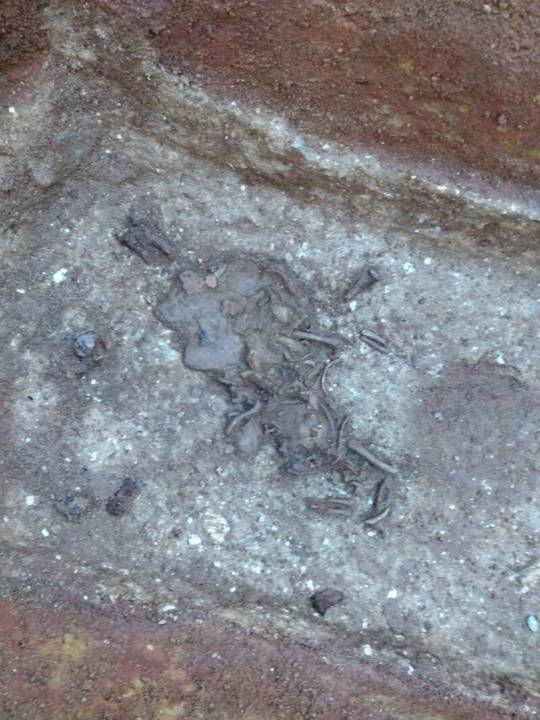

“We know that we are in an area with archaeological potential where there is a 17th-century convent (of Santo António dos Capuchos) to the west, and to the east lies the area where the mosaic of the Ocean God (Deus Oceano), now a national treasure, was found,” he said.
What did come as a surprise to archaeologists was the location of the tombs.
“Based on previous studies, this would have been an area that was possibly residential or more linked to industrial activities. There are many traces of salterns. Largo da Madalena would have been the entrance to the urban area of the city of Ossónoba. The identified graves are in the Figuras area, near Teatro Lethes, close to the Ermida de São Sebastião and the Pavilion of Escola D. Afonso III. This area is almost within the urban fabric,” the archaeologist explained, adding that this illustrates both the “growth and decline of Ossónoba.”
The graves of the man and the woman “were sealed with limestone slabs,” believed to be reused parts from “some of the most emblematic buildings that would have been here in the area,” he believes.
According to the project manager of ERA Arqueologia, who was co-responsible for the work, in addition to the graves, hundreds of small pieces were also discovered which suggest that there may also have been a mosaic there.
The researchers also recovered Roman artifacts in the area, including ceramics, bone dice, nails, pins, a spoon, possible evidence of a dye factory, and coins minted during the reign of Constantine the Great, between A.D. 306 and 337.
Cover Photo: Roman mosaic of the god Oceanus, part of the ancient city of Ossónoba, the modern town of Faro, in Portugal.
By Leman Altuntaş.
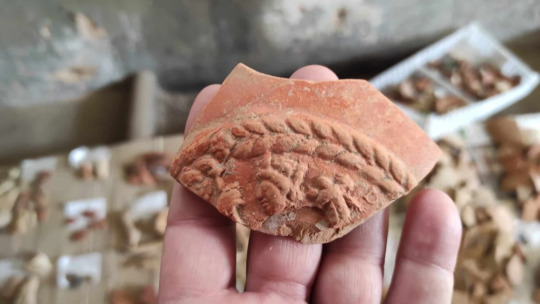
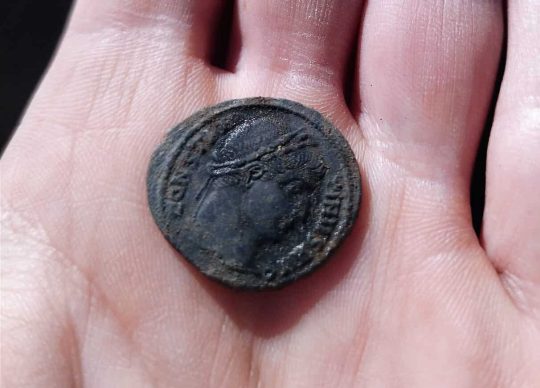
#Three Roman Graves Uncovered in Portugal#Roman city of Ossónoba in Faro#ancient grave#ancient tomb#ancient artifacts#archeology#archeolgst#history#history news#ancient history#ancient culture#ancient civilizations#roman history#roman empire#roman art
257 notes
·
View notes
Note
Emily Prentiss saving reader from an unsub and reader just falls into her arms, sobbing in relief?

ᕚ---ᕘ
In a darkened warehouse in a remote industrial area, the gloomy silence oppressed the air, which was already hard to breathe in due to the thick dust. Emily Prentiss, a supervisory special agent from the Behavioral Analysis Unit, scurried gingerly through the shadowy hallways. Her heartbeat pulsed in her neck vein in harmony with the tension in every fiber of her body. But she had no choice, she was looking for you, a young woman who was the next victim of a notorious serial killer and had potentially been trafficked here.
The dim illumination of the flashlight beneath her drawn weapon bathed the surroundings in a dim light as she lurked and looked around every corner, her weapon tightly gripped in her clammy hands. She had gotten to the middle of the large building when she suddenly heard a faint noise. A stifled whimper under tape or fabric that seemed to come from near an old storage room.
Determined to free you, the black-haired woman moved towards the storage room, her steps deliberate and noiseless. When she reached the door, which was half hanging off its hinges and squeaked gently from the fine blast of air, she listened for a moment before carefully opening it a crack with the barrel of her weapon and shortly afterwards sticking her head through.
Emily's eyes widened in horror and anger as she discovered you tied up and helpless in a dark corner of the room while the suspect, a massive young man with a dark and scowl in his eyes, menacingly approached your powerless body. "FBI! Raise your hands above your head where I can see them!" she shouted with a strong authority in her gravelly voice, her gun unlocked and aimed squarely at the back of the man's head.
The suspect abruptly turned away from you and towards her, a devilish grin on his thin lips, only now did she noticed the shiny silver in his hands. "Agent Prentiss. You're too late to save this pretty thing. She'll be my next trophy and you'll get to watch so it eats you up inside that you couldn't save her in time."
Emily, however, remained calm, her eyes sparkling with determination to free you from the clutches of this monster and get you to safety. “Put the knife down and slowly step away from the woman,” the man in front of her just laughed scornfully and looked back at you for a second. You tried to squeeze yourself deeper into the corner, the look in his eyes deadly. You were panicking. You were afraid for your life. "You won't get in my way, Prentiss. Last time you interfered with my plans and the woman got away. But not this time,"
With a quick movement, he tightened the knife in his hand and rushed towards her, ready to attack and hurt her. But the agent reacted quickly and, as she had learned, ducked skillfully to the side and fired three shots, which, due to her sway in her balance, hit the ground just next to the attacker. The man flinched and frightened for a moment, but his resolve to stop her from saving you seemed undiminished.
In an all-too-quick turn of events, he leapt forward from his crouched position towards her, knife raised high, forcing Emily into an intense hand-to-hand combat. She couldn't use her pistol from such close range. The risk was too high, even for an experienced shooter like her, to hit you and injure or even kill you with one shot. However, her hand-to-hand combat training and experience gave her the advantage over him, but the man was a fierce opponent who would not let go of her until he got what he wanted.
A quick slash of the knife cut the skin above the collarbone, but the agent gritted her teeth and withstood him, her determination to save you unwavering. In a strong counterattack, she cleverly turned to face her, took advantage of the man's open attack area and brought him down, along with herself. She overpowered him and now sat on his thighs, forcing him to drop the knife by grabbing his upper arm and hitting it multiple times on the cold concrete floor before she secured him with handcuffs.
Emily was breathing heavily, the pain in her shoulder was throbbing and the blood was flowing down her dark blue blouse, but her eyes quickly darted to you, who was still cowering in fear in the corner. She quickly freed you from the restraints, pulled the tape from your mouth and hugged you protectively while you fell into her strong arms, sobbing in relief. She was desperately trying to calm you down with gentle words. "It's over, sweetie. You're safe."
More police sirens and their team approached their position in the warehouse as Emily, continuing to ignore her sore shoulder, carefully led you out of the darkness. You shivered uncontrollably in her arms as the cold night air enveloped you, but you also felt a soothing warmth as you clung to your rescuer.
The emotions that overwhelmed you and dragged every fiber of your body into a deep quagmire left you struggling to breathe, and tears began to stream inexorably down your cheeks. Emily pulled you closer to her, feeling the tremble on the side of her body and your pulse beating wildly in your arms as she held you gently. "It's over. You're safe and nothing can happen to you anymore."
Her words were a distant echo in your head as you sobbed desperately, the weight of fear and agony of the last day released in an overwhelming torrent of tears. Your legs felt weak, like you couldn't take another step, but Emily supported you gently, her presence like an anchor in the middle of a violent storm at sea.
The environment around you seemed to fade and you were unsure of your voice, however a few words came out quietly between the sobs, barely audible but full of gratitude and deep relief that Emily had saved you. "Thank you, Agent Prentiss. Thank you for helping me. I thought I would never get out of there alive again."
"That's my job, sweetie. I loved doing it," Emily hugged you gently again, her own heart heavy with compassion. She stroked your back soothingly while a gentle kiss touched your hair. "You've been brave and now you're here and I'm with you. It's over."
The minutes passed as you slowly came out of shock and regained your composure. Your breaths became deeper and slower, your heart calmed and its pulse rate normalized. Emily continued to hold you gently in her arms by the ambulance steps, supporting you until your tears stopped and you were assessed by the paramedics. “Can I go home please?” You murmured in a shaky voice, looking up at her, your eyes red and tired.
The agent nodded gently and stood, lending you a hand to hold you before leading you to her car that was parked nearby. You felt exhausted but also relieved as you sank into the passenger seat of the car, Emily standing by your side.
The drive to your home was filled with a calming silence as Emily made sure to bring you cheerfully back to your family. Only when she sat down on the top steps of your family home and convinced herself that you were safe from now on and were being looked after by trustworthy hands did she leave the house. But not without giving you her private number first so you could call her when you needed someone to talk to.
#emily prentiss#emily prentiss imagine#emily prentiss imagines#emily prentiss fanfiction#emily prentiss x fem!reader#emily prentiss x female reader#emily prentiss x reader#criminal minds#criminal minds fanfic#criminal minds angst#criminal minds imagines#criminal minds fanfiction#fanfic#fanfiction#oneshot#imagines#imagine#criminal minds fic#criminal minds x reader#writeblr#writers of tumblr#emily prentiss fanfic#emily prentiss fic#criminal minds oneshot#criminal minds fiction
255 notes
·
View notes
Text
Insurance companies are making climate risk worse

Tomorrow (November 29), I'm at NYC's Strand Books with my novel The Lost Cause, a solarpunk tale of hope and danger that Rebecca Solnit called "completely delightful."

Conservatives may deride the "reality-based community" as a drag on progress and commercial expansion, but even the most noxious pump-and-dump capitalism is supposed to remain tethered to reality by two unbreakable fetters: auditing and insurance:
https://en.wikipedia.org/wiki/Reality-based_community
No matter how much you value profit over ethics or human thriving, you still need honest books – even if you never show those books to the taxman or the marks. Even an outright scammer needs to know what's coming in and what's going out so they don't get caught in a liquidity trap (that is, "broke"), or overleveraged ("broke," again) exposed to market changes (you guessed it: "broke").
Unfortunately for capitalism, auditing is on its deathbed. The market is sewn up by the wildly corrupt and conflicted Big Four accounting firms that are the very definition of too big to fail/too big to jail. They keep cooking books on behalf of management to the detriment of investors. These double-entry fabrications conceal rot in giant, structurally important firms until they implode spectacularly and suddenly, leaving workers, suppliers, customers and investors in a state of utter higgeldy-piggeldy:
https://pluralistic.net/2022/11/29/great-andersens-ghost/#mene-mene-bezzle
In helping corporations defraud institutional investors, auditors are facilitating mass scale millionaire-on-billionaire violence, and while that may seem like the kind of fight where you're happy to see either party lose, there are inevitably a lot of noncombatants in the blast radius. Since the Enron collapse, the entire accounting sector has turned to quicksand, which is a big deal, given that it's what industrial capitalism's foundations are anchored to. There's a reason my last novel was a thriller about forensic accounting and Big Tech:
https://us.macmillan.com/books/9781250865847/red-team-blues
But accounting isn't the only bedrock that's been reduced to slurry here in capitalism's end-times. The insurance sector is meant to be an unshakably rational enterprise, imposing discipline on the rest of the economy. Sure, your company can do something stupid and reckless, but the insurance bill will be stonking, sufficient to consume the expected additional profits.
But the crash of 2008 made it clear that the largest insurance companies in the world were capable of the same wishful thinking, motivated reasoning, and short-termism that they were supposed to prevent in every other business. Without AIG – one of the largest insurers in the world – there would have been no Great Financial Crisis. The company knowingly underwrote hundreds of billions of dollars in junk bonds dressed up as AAA debt, and required a $180b bailout.
Still, many of us have nursed an ember of hope that the insurance sector would spur Big Finance and its pocket governments into taking the climate emergency seriously. When rising seas and wildfires and zoonotic plagues and famines and rolling refugee crises make cities, businesses, and homes uninsurable risks, then insurers will stop writing policies and the doom will become undeniable. Money talks, bullshit walks.
But while insurers have begun to withdraw from the most climate-endangered places (or crank up premiums), the net effect is to decrease climate resilience and increase risk, creating a "climate risk doom loop" that Advait Arun lays out brilliantly for Phenomenal World:
https://www.phenomenalworld.org/analysis/the-doom-loop/
Part of the problem is political: as people move into high-risk areas (flood-prone coastal cities, fire-threatened urban-wildlife interfaces), politicians are pulling out all the stops to keep insurers from disinvesting in these high-risk zones. They're loosening insurance regs, subsidizing policies, and imposing "disaster risk fees" on everyone in the region.
But the insurance companies themselves are simply not responding aggressively enough to the rising risk. Climate risk is correlated, after all: when everyone in a region is at flood risk, then everyone will be making a claim on the insurance company when the waters come. The insurance trick of spreading risk only works if the risks to everyone in that spread aren't correlated.
Perversely, insurance companies are heavily invested in fossil fuel companies, these being reliable money-spinners where an insurer can park and grow your premiums, on the assumption that most of the people in the risk pool won't file claims at the same time. But those same fossil-fuel assets produce the very correlated risk that could bring down the whole system.
The system is in trouble. US claims from "natural disasters" are topping $100b/year – up from $4.6b in 2000. Home insurance premiums are up (21%!), but it's not enough, especially in drowning Florida and Texas (which is also both roasting and freezing):
https://grist.org/economics/as-climate-risks-mount-the-insurance-safety-net-is-collapsing/
Insurers who put premiums up to cover this new risk run into a paradox: the higher premiums get, the more risk-tolerant customers get. When flood insurance is cheap, lots of homeowners will stump up for it and create a big, uncorrelated risk-pool. When premiums skyrocket, the only people who buy flood policies are homeowners who are dead certain their house is gonna get flooded out and soon. Now you have a risk pool consisting solely of highly correlated, high risk homes. The technical term for this in the insurance trade is: "bad."
But it gets worse: people who decide not to buy policies as prices go up may be doing their own "motivated reasoning" and "mispricing their risk." That is, they may decide, "If I can't afford to move, and I can't afford to sell my house because it's in a flood-zone, and I can't afford insurance, I guess that means I'm going to live here and be uninsured and hope for the best."
This is also bad. The amount of uninsured losses from US climate disaster "dwarfs" insured losses:
https://www.reuters.com/business/environment/hurricanes-floods-bring-120-billion-insurance-losses-2022-2023-01-09/
Here's the doom-loop in a nutshell:
As carbon emissions continue to accumulate, more people are put at risk of climate disaster, while the damages from those disasters intensifies. Vulnerability will drive disinvestment, which in turn exacerbates vulnerability.
Also: the browner and poorer you are, the worse you have it: you are impacted "first and worst":
https://www.climaterealityproject.org/frontline-fenceline-communities
As Arun writes, "Tinkering with insurance markets will not solve their real issues—we must patch the gaping holes in the financial system itself." We have to end the loop that sees the poorest places least insured, and the loss of insurance leading to abandonment by people with money and agency, which zeroes out the budget for climate remediation and resiliency where it is most needed.
The insurance sector is part of the finance industry, and it is disinvesting in climate-endagered places and instead doubling down on its bets on fossil fuels. We can't rely on the insurance sector to discipline other industries by generating "price signals" about the true underlying climate risk. And insurance doesn't just invest in fossil fuels – they're also a major buyer of municipal and state bonds, which means they're part of the "bond vigilante" investors whose decisions constrain the ability of cities to raise and spend money for climate remediation.
When American cities, territories and regions can't float bonds, they historically get taken over and handed to an unelected "control board" who represents distant creditors, not citizens. This is especially true when the people who live in those places are Black or brown – think Puerto Rico or Detroit or Flint. These control board administrators make creditors whole by tearing the people apart.
This is the real doom loop: insurers pull out of poor places threatened by climate disasters. They invest in the fossil fuels that worsen those disasters. They join with bond vigilantes to force disinvestment from infrastructure maintenance and resiliency in those places. Then, the next climate disaster creates more uninsured losses. Lather, rinse, repeat.
Finance and insurance are betting heavily on climate risk modeling – not to avert this crisis, but to ensure that their finances remain intact though it. What's more, it won't work. As climate effects get bigger, they get less predictable – and harder to avoid. The point of insurance is spreading risk, not reducing it. We shouldn't and can't rely on insurance creating price-signals to reduce our climate risk.
But the climate doom-loop can be put in reverse – not by market spending, but by public spending. As Arun writes, we need to create "a global investment architecture that is safe for spending":
https://tanjasail.wordpress.com/2023/10/06/a-world-safe-for-spending/
Public investment in emissions reduction and resiliency can offset climate risk, by reducing future global warming and by making places better prepared to endure the weather and other events that are locked in by past emissions. A just transition will "loosen liquidity constraints on investment in communities made vulnerable by the financial system."
Austerity is a bad investment strategy. Failure to maintain and improve infrastructure doesn't just shift costs into the future, it increases those costs far in excess of any rational discount based on the time value of money. Public institutions should discipline markets, not the other way around. Don't give Wall Street a veto over our climate spending. A National Investment Authority could subordinate markets to human thriving:
https://democracyjournal.org/arguments/industrial-policy-requires-public-not-just-private-equity/
Insurance need not be pitted against human survival. Saving the cities and regions whose bonds are held by insurance companies is good for those companies: "Breaking the climate risk doom loop is the best disaster insurance policy money can buy."
I found Arun's work to be especially bracing because of the book I'm touring now, The Lost Cause, a solarpunk novel set in a world in which vast public investment is being made to address the climate emergency that is everywhere and all at once:
https://us.macmillan.com/books/9781250865939/the-lost-cause
There is something profoundly hopeful about the belief that we can do something about these foreseeable disasters – rather than remaining frozen in place until the disaster is upon us and it's too late. As Rebecca Solnit says, inhabiting this place in your imagination is "Completely delightful. Neither utopian nor dystopian, it portrays life in SoCal in a future woven from our successes (Green New Deal!), failures (climate chaos anyway), and unresolved conflicts (old MAGA dudes). I loved it."

If you'd like an essay-formatted version of this post to read or share, here's a link to it on pluralistic.net, my surveillance-free, ad-free, tracker-free blog:
https://pluralistic.net/2023/11/28/re-re-reinsurance/#useless-price-signals
#pluralistic#doom loop#insurance#insuretech#climate#climate risk#climate emergency#the lost cause#market forces#risk management#price signals#control boards#decarbonization#bond vigilantes#climate resilience
266 notes
·
View notes
Text
A word on Wardpark/Cumbernauld Studios
@docsama left a comment, on S's birthday, under one of my posts and I promised her an answer with more information, as soon as I got the time. Anyway, here goes - and @docsama, sorry for the delay:

Question is: who owns the Wardpark Film and Television Studios?
The answer was quick to find, in the not-so-old specialized media:


The story begins in 2013, with an ambitious Scottish entrepreneur, Terry Thomson - this guy (courtesy of The Herald, https://www.heraldscotland.com/news/15984820.analysis-three-projects-pipeline-help-productions-make-big-picture/):

He is the owner of the Thomson Pettie Group, based in Carluke (https://www.thomsonpettie.com/about-us), which has nothing to do with cinema:
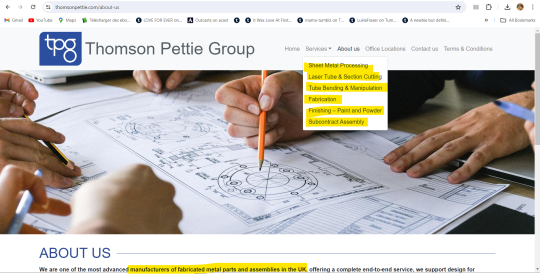
You've read that right: they are 'manufacturers of fabricated metal parts and assemblies', primarily for the national automotive industry. Yet, in 2013, Mr. Thomson agreed to rent what he described as 'a dormant industrial property' - a warehouse, to be exact - to Sony, in order to host the filming and production of OL. Thus, he became the CEO of a newly created entity, The Wardpark Film and Television Studios (https://www.hackmancapital.com/scotlands-largest-most-iconic-film-studio-acquired-by-hackman-capital-partners-and-square-mile-capital/).
By 2017, Wardpark was doing so well, that a big expansion plan was announced, with the direct support of the Scottish Government, which invested £4 million via Scottish Enterprise, its business support, advice and funding agency:
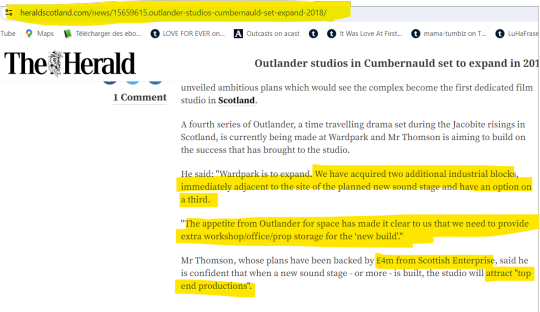
And then, in November 2021, the little engine that could was sold to those two big US investors, Hackman Capital Partners (HCP) and Square Mile Capital Management LLC (now globally rebranded as Affinius Capital). In this montage, Hackman Capital Partners brought its own confirmed film studios and media management expertise...
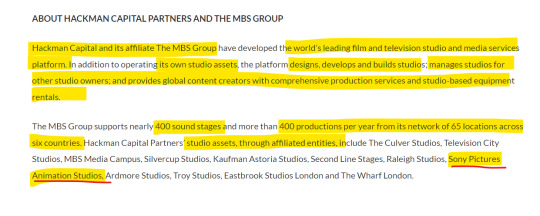
... while Square Mile most probably funded a sizeable portion of the acquisition, simply because this is what they do best:

Perhaps an interesting detail: HCP owns and manages both the Culver City based Sony Pictures Animation Studios' Campus and the legendary Culver Studios, now rebranded by Amazon:

Back to Scotland, Wardpark Studio's sale made just about everyone happy. Mr. Thomson kept his CEO job and look who was more than thrilled about the juicy transaction:
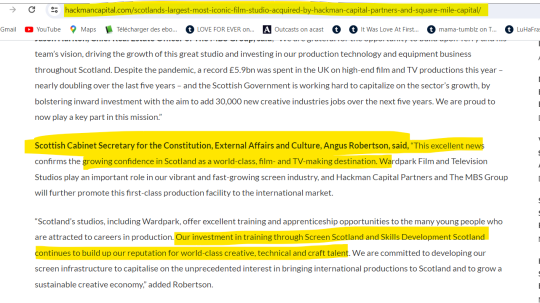
Currently, the studio is operated by HCP's subsidiary, The MBS Group:

That means that MBS probably manages just about everything, as far as daily management is concerned, from business operations, staffing and/or property management, to lighting and grip, trucks and generators' fleet, expendables and props. Unless I could see a contract and have a precise idea, I can just enumerate all the services they offer.
At no point in time did S and C own anything of those studios. As for the Executive Producer part, that is another discussion entirely. I could be coaxed to write something about it, if you really want to know why Those Two are EPs and what does that really, really mean - because once again, I have seen and read a LOT of bullshit in here, especially in the Desperate Housewives Disgruntled Tumblrettes' corner.
Thank you for asking. It was fun to research and write and I hope it brought more clarity to you.
100 notes
·
View notes
Text
A Fine Line: Truth vs. Speculation
Due to popular demand, I will be taking a closer look at the infamous “FictionJunction & Kalafina Behind the Scenes” essay which is posted in three separate parts on a Livedoor Blog
UPDATE 24/10/10: As of October 8, the blog seems to have been deleted. Further proof of the author's questionable intentions if you ask me. But hey, nothing is ever truly gone on the internet so I will be using internet archives for my analysis.
UPDATE 24/10/17: Yuki Kajiura has addressed the blog in her most recent FC radio broadcast. She has read through it and wants us to know that all the “facts” are pure fabrications, especially the conspiracy theories regarding Sony wanting to control her and trying to slowly get rid of her involvement in Kalafina.
A few days ago, I provided some context and background info on the author so be sure to check out THAT POST before you read this one. While working my way through the individual sections, I will try my best to highlight the speculative parts for you so you know what you are dealing with.
Disclaimer: I will do this to the best of my knowledge and ability but please remember to remain critical at all times. You should always take these things with a grain of salt. While I would usually not hesitate to call myself somewhat of an expert on all things Kalafina, the same is not true when it comes to Yuki Kajiura. So even if my opinions and thoughts are well-founded, this should definitely not serve as a be-all and end-all source for you.
Parameters: I will highlight anything as "speculation" that doesn't qualify as cold, hard fact. This will entail straight-up lies, half-truths, conclusions with no causal links and full-on delusions of course but also more subtle things like exaggerations, embellishments, headcanons or projections of personal feelings.
Use of Auto Translate: Since my main goal is to reveal the speculative parts of the essay for casual fans, I want to save some time by simply putting the website through the automatic Chrome translation tool. It's not ideal and won't always make perfect sense (especially regarding the use of pronouns) but for now, it's the most convenient option. If there are any outlandish translations, I'll try my best to clarify them. For the purpose of this analysis, the translation should be fine though. I also blurred out all the photo descriptions in the screenshots because they were distracting, I've not removed any of the relevant text parts. ╭────────────.★..─╮ LET'S GO〈(•ˇ‿ˇ•)-→ ╰─..★.────────────╯
Intro & Addendum ① The truth behind Kajiura Yuki’s departure from the agency ② The truth behind Kalafina’s split and hiatus ③ The activities of the members and Kajiura after Kalafina’s hiatus ④ The circumstances that led to Kalafina’s reunion and the truth behind Kajiura’s anger ⑤ Rights related to Kalafina

~Intro~ & Addendum

For clarification, the phrase "former member of the group" is a clunky translation of the part where the author refers to themselves as an “industry insider”, someone who has “formerly been affiliated” with Yuki Kajiura and Kalafina. Obviously, I believe this to be a total fabrication of the author who is aiming for attention and clout. I've already discussed this quite thoroughly in MY POST HERE so I won't go into detail again. Suffice it to say, I believe this person is an imposter pretending to have exclusive insider knowledge. As for the claim that these blog posts are "only focusing on facts", well, I beg to differ. While facts surely make up the basic framework of the essay, it is also filled with lots of unsubstantiated statements. Additionally, I am not buying into the whole "no intention of criticising anyone" thing because quite frankly, there's a lot of criticising and accusing going on here regarding Space Craft and Sony. Plus, this entire essay reflects super badly on Wakana. It's nothing obvious of course but there are subtle patterns that run like a red thread through the whole text (I'll highlight them once we get to the sections in question).
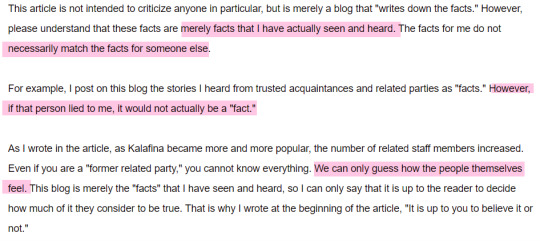
The addendum is basically a reiteration of the intro, serving to protect the author against any possible accusations of deception/fraud. However, they are doing a very bad job at trying to convince us of their credibility. What do you mean by "merely facts that you have seen and heard and that don't necessarily align with the facts of someone else"???!! Maybe this person struggles with the definition of the word "fact" but what makes a fact is solid evidence and not some random hearsay. It's also in the nature of facts to be true for everyone and not just for individual people. Oh well, what can you expect?
① The truth behind Kajiura Yuki’s departure from the agency
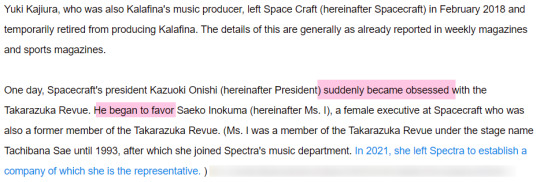


I have no issue with the names mentioned here. Those people have all indeed been part of Space Craft at one point or are still associated with the agency. You can find their names in Kalafina's credit booklets so that's undisputed. However, I do take issue with the strong focus on interpersonal relationships and soap opera drama. None of this has ever been officially confirmed (it's only ever been reported in tabloid papers). It's true that management positions at Space Craft have changed very frequently. You can see in the credit booklets that positions were switched up on a regular basis (with special titles changing just as often) which indicates that Space Craft has undergone a lot of restructuring throughout the years. Changes on management level are of course a very common practice in many companies. It's natural that some people will benefit from this and others will feel slighted. Obviously, these changes are not always triggered by professional reasons, there's a high possibility of private reasons being involved as well. However, there is no way of knowing whether Onishi was "obsessed" with anyone or if certain people were "being favoured" while others were "abused" and "demoted", these are merely speculations. At any rate, the fact that Inokuma has left the agency as well would suggest that the supposed special treatment wasn't so special after all. Mori may or may not have had his personal sensibilities offended which prompted his departure from Space Craft but the exact reasons behind it all have not been disclosed. "Often had disagreements over the direction due to Inokuma not understanding the process": Creative differences have been cited a few times as one of the reasons for YK's departure but that's the extent of our knowledge. We are not aware of any details as to who she's had those differences with or what exactly they couldn't agree on. There's also no way for us to judge Inokuma's skills as director/manager (or really anyone's for that matter). Not sure if Yuki has ever "negotiated her rights with a lawyer", I've personally not heard/read about that. Then we have Yuki's current status. Her partnership/association with Highway Star would suggest that she is not actually a "freelancer" in the strict sense of the word. In credit booklets, the agency is always listed as "artist management" alongside Yuki's own company FictionJunctionMusic so her status is a bit ambivalent if you ask me. But to be fair, that's neither here nor there, not really relevant for this analysis anyway. Claiming that YK is now able to "pursue her musical career more freely" seems a bit weird to me since Yuki has gone on record several times saying that she's never had more creative freedom than when she was working on Kalafina's music. There's no doubt that she is now doing a lot more soundtracks and live shows again but that's obviously because she has more free time to focus on that instead of new releases for Kalafina. Also, the main difference between then and now is that the huge success of Demon Slayer has afforded her the financial means to considerably expand her live activities. She's clearly enjoying the emphasis on concerts and events but we've no idea how happy she is about providing all those songs/scores to different shows/artists compared to how she felt when she was working on music for Kalafina...I'd argue it's not as fulfilling or fun. After all, she has been writing songs for all sorts of stuff during the Kalafina days and long before that too so nothing has changed about that.
② The truth behind Kalafina’s split and hiatus
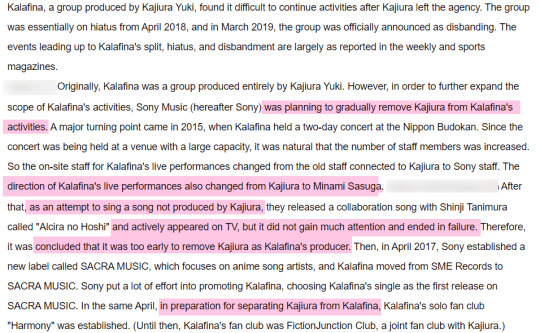
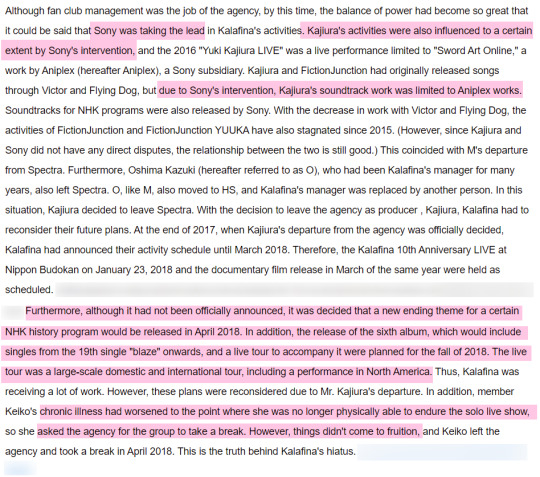
For some reason, the author seems to be convinced that the higher ups at Sony were on an evil mission to "gradually get rid of Yuki Kajiura's involvement" so according to this essay, every change that happened throughout the years was just one step further into that direction. This is completely baseless and honestly makes no sense. There's zero evidence that either Sony or Space Craft ever wanted to remove YK from the project "Kalafina" before that whole falling-out thing happened. Quite the contrary actually, Yuki was always in charge of the music production and the higher-ups would never have given her so much free rein if Yuki's unconditional involvement wasn't exactly what they wanted. Did they involve more staff members when Kalafina became more popular and mainstream? Of course. It takes a lot of people and talent to handle activities on a larger scale. And since Yuki was busy working on new music almost all the time, there was no way she could have possibly handled all those things by herself. Apart from that, it was clearly necessary to bring in people with new ideas who knew how to adjust Kalafina's activities and marketing to better match their growing popularity and entry into mainstream territory. Many fans have bemoaned the fact that Kalafina had become too mainstream and idol-like in their later years but the truth is, if it hadn't been for these changes, Kalafina might never have gotten this far in terms of reach and success. The rather lackluster reactions to Kalafina's 10th Anniversary Live production are proof enough that a majority of fans actually preferred the more elaborate stage productions with dramatic elements, choreography and fan-service from the previous years. This is where people like "Minami Sasuga" come in, she is the one responsible for many of Kalafina's more engaging and epic live performances. For Yuki, the focus was always on singing so she never thought much of elaborate live productions but she obviously knew it was the price to pay for success. To conclude, no one was brought in to replace or drive away YK, they were merely invited to fill gaps that were in dire need of filling. The suggestion that a few "TV appearances and a collaboration with Shinji Tanimura" were failed attempts by Sony/Space Craft to "distance Kalafina from Yuki Kajiura" is once again utterly baseless. We have no evidence of that. How do those things even correlate to each other? Doing one thing doesn't exclude the other. If anything, these were attempts to broaden Kalafina's reach among different audiences. That part about "Sony intervening with Yuki's work/activities" also seems quite fishy. I have no details on this but what reasons would Sony have for those sort of restrictions all of a sudden if they had been fine with the situation all those years before? Not to mention that Sony (SACRA MUSIC to be more specific) is currently collaborating with Yuki again and there seem to be no issues about her performing all the old Victor stuff. All the things about Kalafina's cancelled activities in 2018 ("world tour, singles, albums, etc") are pure speculations taken from tabloid articles. Nothing has ever been confirmed. Might be true, might be a fabrication, we'll probably never know for sure. While it's certainly true that Keiko had been suffering from a "chronic illness" at that time (that sometimes made it impossible for her to do her job), the phrasing here makes it seem as if she was purposefully denied breaks and forced to perform when she was physically incapable. The truth is more nuanced. We do know that she got to take breaks if she needed them and whenever we actually saw her performing, there was never a point where she wasn't able to deliver solid vocals. It's easy to demonise the agency by saying they had poor Keiko slave away while suffering but based on what we know of Keiko's character, it was always her decision to keep working, she's the type to push through because she's not willing to let anyone down.
③ The activities of the members and Kajiura after Kalafina's hiatus
Keiko
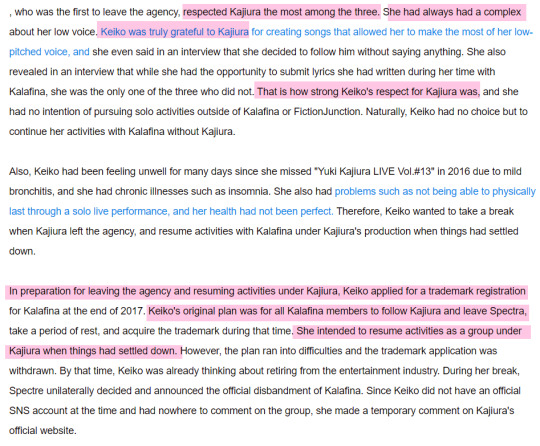
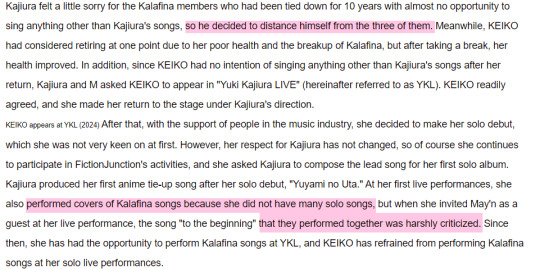
Not for one second do I doubt "Keiko's strong respect" for Yuki Kajiura but I don't like the way this is framed. Somehow the girls are implicitly judged based on their level of respect for YK. And while Keiko is put on a pedestal here with her hero worship and unconditional loyalty, Wakana is the clear loser of this evaluation according to the author (see the section below). Also, why feel the need to include Keiko's little anecdote about her "low-voice complex"? Does anyone really believe that all the love and respect between Yuki and Keiko is based on something trivial like this? Yes, Keiko likes to tell the story about her low voice and she was obviously happy to get some positive feedback but this is in no way, shape or form the foundation of their relationship. We actually don't know anything about Keiko's motivation for that "trademark registration". She's never talked about it. She may have had plans as described above but to state it as fact is quite bold. YK has mentioned in interviews that she felt a little sad about the girls not getting to explore their own interests for a whole decade but I don't recall her saying that she was ever trying to "actively distance herself from them". Any perceived distance was caused by the rift between Space Craft, Yuki and Mori. Keiko, just like the other two members, did not "focus on Kalafina songs in the beginning" because she had nothing else to sing, it was more of a matter of wanting to please the fans who were obviously coming in with certain expectations. All three of them realised very quickly though that it was best to mostly/completely stay away from Kalafina covers for a number of reasons. I'd argue though that people "harshly criticising their covers" is very low on their list of reasons to avoid them.
Hikaru
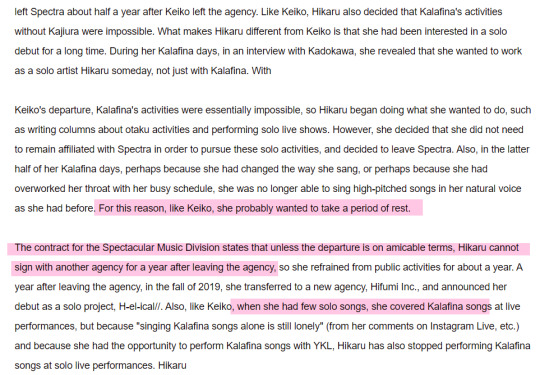
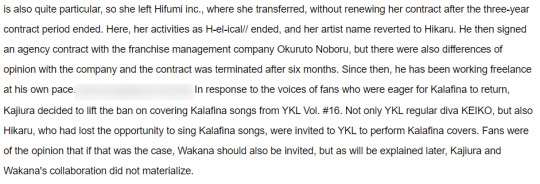
We don't know what exactly caused the changes in Hikaru's voice and whether or not she "wanted to take a break to recover". This theory is unlikely though since there haven't really been any real "improvements" to her condition. She simply adapted to the state of her voice and sometimes it works for songs, other times it doesn't. The author refers to stipulations in the Space Craft contract that keep clients "from signing with another agency for a year after departure". This theory has been floating around forever and I've always found it to be quite plausible but once again, the author is stating it as fact here which I find problematic.
Wakana
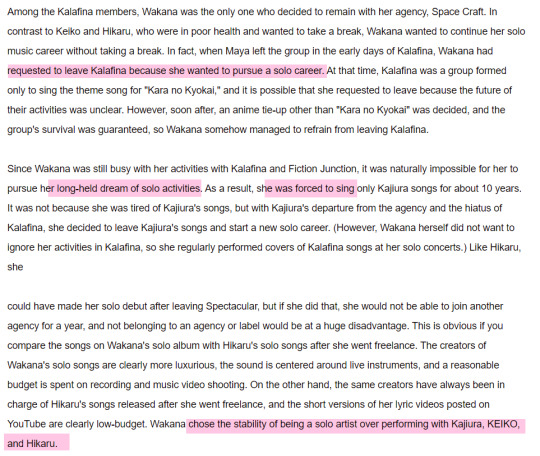
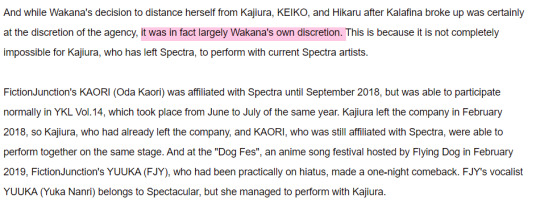

This entire section somehow seems to imply that Wakana never cared about Kalafina or Yuki Kajiura and if you know anything about me, then you will not be surprised that I'm taking full offense at such claims. Portraying Wakana as the only one "who wanted nothing to do with Kalafina in favour of pursuing a solo career" is just wild. As far as we know, Wakana never had such a strong desire to be a solo artist (she actually often voiced her insecurities about performing alone) but still, this author makes it sound as if she was more invested in that dream than even Hikaru and willing to just abandon the Kalafina project. Completely untrue. For a while back in the early days, Kalafina was in a very fragile state with no concrete plans for the future. Members were not intended to be regular and everything happened on a tentative basis so of course, this would make everyone involved feel a little uncertain. No promises had been made to them, they had nothing to rely on so they would naturally have needed to look at other work options but obviously, none of them committed to anything else since they ended up becoming regular members of Kalafina. Again with this idea of Wakana "pining for her long-held dream of a solo career and being forced to sing YK's music" . Where does this person get their info? Hikaru has always been the only one among the three of them with the confidence and desire to stand alone on stage. Wakana is a lot more similar to Keiko in that regard, meaning that she prefers the comfort of having someone else on stage with her. That's not to say that she didn't have dreams of exploring her own music one day (and she has obviously been having fun throughout her solo career) but she certainly never minded being guided by Yuki and her fellow group members. Just like the other girls, she holds YK in high regard and treasures the music she has written for them. Wakana "chose stability over performing with Keiko, Hikaru and YK". The way this is phrased irks me so much because it is so clearly making Wakana out to be the bad guy in the situation. The person just named all the reasons why it was beneficial for Wakana to stay and in contrast, they also described the fate that would have awaited her if she had left as well. So yeah, Wakana chose relative stability over certain instability (as seen with Hikaru's circumstances). Not being able to perform with Keiko, Hikaru and YK was unfortunately one of the prices that had to be paid due to strict rules but to suggest she pretty much dropped them all like a hot potato for the sake of a bit of comfort is simply slanderous. And now the author is trying to convince us that there has never actually been any ban for Wakana, that "it has always been largely at her own discretion", that she is simply choosing to not collaborate with anyone for shits and giggles. Why would you say that? Just because we've examples of other Space Craft clients being able to work together with YK? That's completely irrelevant and has zero significance for Wakana's situation. Do we know what's in her contract? No. Do we know if it's the same contract as Yuuka Nanri's or Kaori's or anyone else's for that matter? No. So why make those conclusions?! We don't know anything about that. I find it rude to even suggest that Wakana and YK would willingly avoid working with each other again because even if this author might not believe it, there's certainly a huge amount of mutual respect between them.
④ The circumstances that led to Kalafina's reunion and the truth behind Kajiura's anger

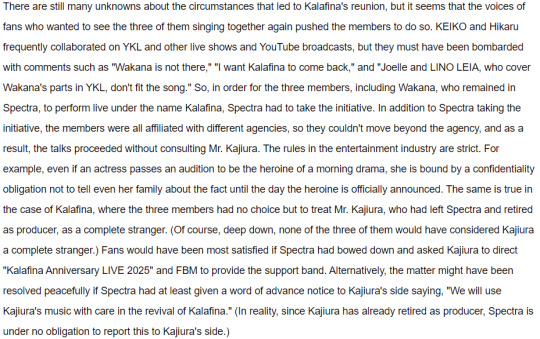

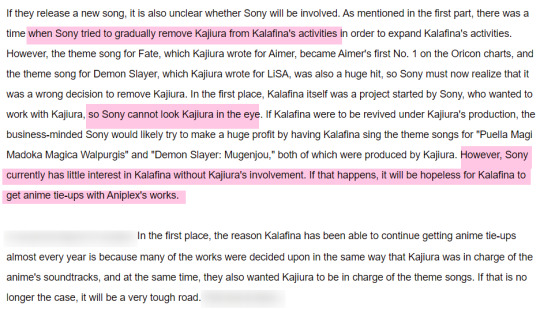
Hm, is it "Space Craft's pride" alone that's stopping a proper reconciliation? Or Yuki's pride? Or Mori's pride? Or everyone's pride? I always hesitate to point the finger at just one involved party with disputes like this. It usually takes more than one party for a falling-out on such a large scale. I think there is a lot of hurt pride involved in this debacle. Yuki's official statement on the reunion live is a prime example of hurt pride. Of course she has every right to feel slighted but this was not a professional reaction. Say what you will about Space Craft treating the girls horribly but they are not always the sole perpetrator. I mean, yeah, the agency was their usual petty self by purposefully excluding YK and making the girls sign confidentiality agreements which surely caused them to feel uncomfortable but who was it that lashed out irrationally in public, essentially threw the Kalafina members under the bus and stirred up hatred against them? All I'm saying is that it is not as black-and-white as this person would have you believe. Everything else in this section is just pure speculation about future Kalafina projects. It's too early for that and I really see no point in coming up with all these prophecies of doom. It's funny though that according to the author, "Sony would suddenly not be interested in Kalafina without Yuki's involvement when they previously were so adamant about getting rid of her..." There's really no proof that Sony had no faith in Yuki's work prior to her success with Aimer and LiSA.
⑤ Rights related to Kalafina
I have no real qualms with the following sections. This part seems pretty well-researched and checks-out. While I'm not 100% familiar with all the legal aspects, this is information that can be looked up online. What I've found during my own research on music rights in Japan more or less aligns with what is stated here. So feel free to go through this without worrying too much about speculations.
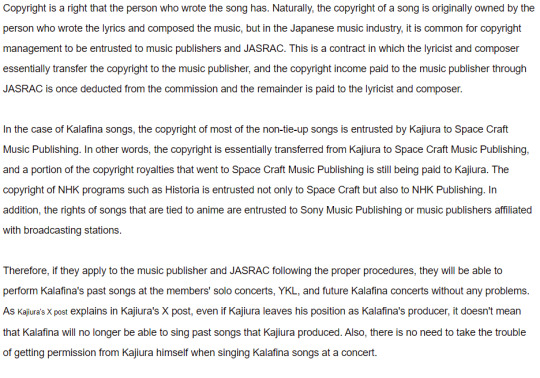
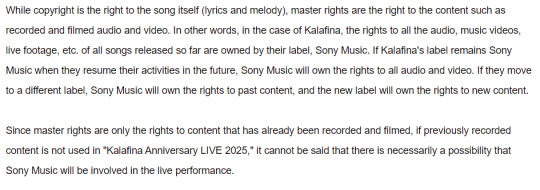


I'm very glad the author puts emphasis on the fact that the girls are not the kind of people to be disloyal. Kudos to them!
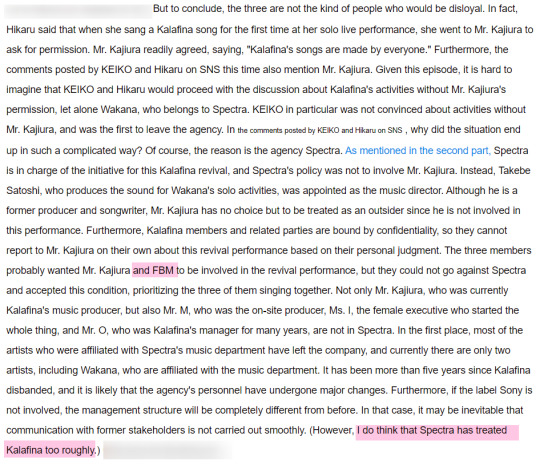
We actually don't know yet what the "front band members" will do. Maybe they'll refuse to appear at the live out of loyalty to Yuki? Or maybe they will decide to support this reunion because the girls also mean a lot to them? None of them are bound by any rules, confidentiality agreements or stipulations so they can basically do whatever they want.
Regarding "Space Craft treating Kalafina too roughly", other people might feel differently but I still have faith in the girls. As far as I am concerned, they knew what they were getting into when they signed a deal with Space Craft. I mean, surely no one was holding a weapon to their head when they decided to do this so they must have collectively agreed that it was a good idea (at least in the beginning phase). I am not denying that this is currently a shit-show and that things are being handled in a very poor manner. It's the typical M.O. for Space Craft and they do deserve some of the backlash for that but let's be real here, so far, the roughest treatment has definitely not come from the agency. It has come from the fans themselves who've been hurling insults and accusations at the girls almost non-stop so maybe the fandom should first and foremost look inward instead of blaming Space Craft for everything.
»»———-THE END———-««
All right, that's it. A cookie for everyone who managed to read through all of this. Sorry for all the typos. I wanted to get this out last night but I should have done a little proof-reading first. Will edit the post whenever I have a little free-time.
#kalafina#random#personal#speculation#kalafina reunion#long text post#picture heavy#yuki kajiura#kajiura yuki#space craft#spacecraft#should drink red bull more often#making me very productive XD#this took forever tho
19 notes
·
View notes
Text

F.7 How does the history of “anarcho”-capitalism show that it is not anarchist?
Of course, “anarcho”-capitalism does have historic precedents and “anarcho”-capitalists spend considerable time trying to co-opt various individuals into their self-proclaimed tradition of “anti-statist” liberalism. That, in itself, should be enough to show that anarchism and “anarcho”-capitalism have little in common as anarchism developed in opposition to liberalism and its defence of capitalism. Unsurprisingly, these “anti-state” liberals tended to, at best, refuse to call themselves anarchists or, at worse, explicitly deny they were anarchists.
One “anarcho”-capitalist overview of their tradition is presented by David M. Hart. His perspective on anarchism is typical of the school, noting that in his essay anarchism or anarchist “are used in the sense of a political theory which advocates the maximum amount of individual liberty, a necessary condition of which is the elimination of governmental or other organised force.” [“Gustave de Molinari and the Anti-statist Liberal Tradition: Part I”, pp. 263–290, Journal of Libertarian Studies, vol. V, no. 3, p. 284] Yet anarchism has never been solely concerned with abolishing the state. Rather, anarchists have always raised economic and social demands and goals along with their opposition to the state. As such, anti-statism may be a necessary condition to be an anarchist, but not a sufficient one to count a specific individual or theory as anarchist.
Specifically, anarchists have turned their analysis onto private property noting that the hierarchical social relationships created by inequality of wealth (for example, wage labour) restricts individual freedom. This means that if we do seek “the maximum of individual liberty” then our analysis cannot be limited to just the state or government. Thus a libertarian critique of private property is an essential aspect of anarchism. Consequently, to limit anarchism as Hart does requires substantial rewriting of history, as can be seen from his account of William Godwin.
Hart tries to co-opt of William Godwin into the ranks of “anti-state” liberalism, arguing that he “defended individualism and the right to property.” [Op. Cit., p. 265] He, of course, quotes from Godwin to support his claim yet strangely truncates Godwin’s argument to exclude his conclusion that ”[w]hen the laws of morality shall be clearly understood, their excellence universally apprehended, and themselves seen to be coincident with each man’s private advantage, the idea of property in this sense will remain, but no man will have the least desire, for purposes of ostentation or luxury, to possess more than his neighbours.” In other words, personal property (possession) would still exist but not private property in the sense of capital or inequality of wealth. For Godwin, “it follows, upon the principles of equal and impartial justice, that the good things of the world are a common stock, upon which one man has a valid a title as another to draw for what he wants.” [An Enquiry into Political Justice, p. 199 and p. 703] Rather than being a liberal Godwin moved beyond that limited ideology to provide the first anarchist critique of private property and the authoritarian social relationships it created. His vision of a free society would, to use modern terminology, be voluntary (libertarian) communism.
This analysis is confirmed in book 8 of Godwin’s classic work, entitled “On Property.” Needless to say, Hart fails to mention this analysis, unsurprisingly as it was later reprinted as a socialist pamphlet. Godwin thought that the “subject of property is the key-stone that completes the fabric of political justice.” Like Proudhon, he subjected property as well as the state to an anarchist analysis. For Godwin, there were “three degrees” of property. The first is possession of things you need to live. The second is “the empire to which every man is entitled over the produce of his own industry.” The third is “that which occupies the most vigilant attention in the civilised states of Europe. It is a system, in whatever manner established, by which one man enters into the faculty of disposing of the produce of another man’s industry.” He notes that it is “clear therefore that the third species of property is in direct contradiction to the second.” [Op. Cit., p. 701 and p. 710–2] The similarities with Proudhon’s classic analysis of private property are obvious (and it should be stressed that the two founders of the anarchist tradition independently reached the same critique of private property).
Godwin, unlike classical liberals, saw the need to “point out the evils of accumulated property,” arguing that the “spirit of oppression, the spirit of servility, and the spirit of fraud … are the immediate growth of the established administration of property. They are alike hostile to intellectual and moral improvement.” Thus private property harms the personality and development those subjected to the authoritarian social relationships it produces, for “accumulation brings home a servile and truckling spirit” and such accumulated property “treads the powers of thought in the dust, extinguishes the sparks of genius, and reduces the great mass of mankind to be immersed in sordid cares.” This meant that the “feudal spirit still survives that reduced the great mass of mankind to the rank of slaves and cattle for the service of a few.” Like the socialist movement he inspired, Godwin argued that “it is to be considered that this injustice, the unequal distribution of property, the grasping and selfish spirit of individuals, is to be regarded as one of the original sources of government, and, as it rises in its excesses, is continually demanding and necessitating new injustice, new penalties and new slavery.” He stressed, “let it never be forgotten that accumulated property is usurpation” and considered the evils produced by monarchies, courts, priests, and criminal laws to be “imbecile and impotent compared to the evils that arise out of the established administration of property.” [Op. Cit., p. 732, p. 725, p. 730, p. 726, pp. 717–8, p. 718 and p. 725]
Unsurprisingly given this analysis, Godwin argued against the current system of property and in favour of “the justice of an equal distribution of the good things of life.” This would be based on ”[e]quality of conditions, or, in other words, an equal admission to the means of improvement and pleasure” as this “is a law rigorously enjoined upon mankind by the voice of justice.” [Op. Cit., p. 725 and p. 736] Thus his anarchist ideas were applied to private property, noting like subsequent anarchists that economic inequality resulted in the loss of liberty for the many and, consequently, an anarchist society would see a radical change in property and property rights. As Kropotkin noted, Godwin “stated in 1793 in a quite definite form the political and economic principle of Anarchism.” Little wonder he, like so many others, argued that Godwin was “the first theoriser of Socialism without government — that is to say, of Anarchism.” [Environment and Evolution, p. 62 and p. 26] For Kropotkin, anarchism was by definition not restricted to purely political issues but also attacked economic hierarchy, inequality and injustice. As Peter Marshall confirms, “Godwin’s economics, like his politics, are an extension of his ethics.” [Demanding the Impossible, p. 210]
Godwin’s theory of property is significant because it prefigured what was to become standard nineteenth century socialist thought on the matter. In Britain, his ideas influenced Robert Owen and, as a result, the early socialist movement in that country. His analysis of property, as noted, was identical to and predated Proudhon’s classic anarchist analysis. As such, to state, as Hart did, that Godwin simply “concluded that the state was an evil which had to be reduced in power if not eliminated completely” while not noting his analysis of property gives a radically false presentation of his ideas. [Op. Cit., p. 265] However, it does fit into his flawed assertion that anarchism is purely concerned with the state. Any evidence to the contrary is simply ignored.
#anarcho capitalism#anarcho capitalist#faq#anarchy faq#revolution#anarchism#daily posts#communism#anti capitalist#anti capitalism#late stage capitalism#organization#grassroots#grass roots#anarchists#libraries#leftism#social issues#economy#economics#climate change#climate crisis#climate#ecology#anarchy works#environmentalism#environment#solarpunk#anti colonialism#mutual aid
18 notes
·
View notes
Text
In 2023, the fast-fashion giant Shein was everywhere. Crisscrossing the globe, airplanes ferried small packages of its ultra-cheap clothing from thousands of suppliers to tens of millions of customer mailboxes in 150 countries. Influencers’ “#sheinhaul” videos advertised the company’s trendy styles on social media, garnering billions of views.
At every step, data was created, collected, and analyzed. To manage all this information, the fast fashion industry has begun embracing emerging AI technologies. Shein uses proprietary machine-learning applications — essentially, pattern-identification algorithms — to measure customer preferences in real time and predict demand, which it then services with an ultra-fast supply chain.
As AI makes the business of churning out affordable, on-trend clothing faster than ever, Shein is among the brands under increasing pressure to become more sustainable, too. The company has pledged to reduce its carbon dioxide emissions by 25 percent by 2030 and achieve net-zero emissions no later than 2050.
But climate advocates and researchers say the company’s lightning-fast manufacturing practices and online-only business model are inherently emissions-heavy — and that the use of AI software to catalyze these operations could be cranking up its emissions. Those concerns were amplified by Shein’s third annual sustainability report, released late last month, which showed the company nearly doubled its carbon dioxide emissions between 2022 and 2023.
“AI enables fast fashion to become the ultra-fast fashion industry, Shein and Temu being the fore-leaders of this,” said Sage Lenier, the executive director of Sustainable and Just Future, a climate nonprofit. “They quite literally could not exist without AI.” (Temu is a rapidly rising ecommerce titan, with a marketplace of goods that rival Shein’s in variety, price, and sales.)
In the 12 years since Shein was founded, it has become known for its uniquely prolific manufacturing, which reportedly generated over $30 billion of revenue for the company in 2023. Although estimates vary, a new Shein design may take as little as 10 days to become a garment, and up to 10,000 items are added to the site each day. The company reportedly offers as many as 600,000 items for sale at any given time with an average price tag of roughly $10. (Shein declined to confirm or deny these reported numbers.) One market analysis found that 44 percent of Gen Zers in the United States buy at least one item from Shein every month.
That scale translates into massive environmental impacts. According to the company’s sustainability report, Shein emitted 16.7 million total metric tons of carbon dioxide in 2023 — more than what four coal power plants spew out in a year. The company has also come under fire for textile waste, high levels of microplastic pollution, and exploitative labor practices. According to the report, polyester — a synthetic textile known for shedding microplastics into the environment — makes up 76 percent of its total fabrics, and only 6 percent of that polyester is recycled.
And a recent investigation found that factory workers at Shein suppliers regularly work 75-hour weeks, over a year after the company pledged to improve working conditions within its supply chain. Although Shein’s sustainability report indicates that labor conditions are improving, it also shows that in third-party audits of over 3,000 suppliers and subcontractors, 71 percent received a score of C or lower on the company’s grade scale of A to E — mediocre at best.
Machine learning plays an important role in Shein’s business model. Although Peter Pernot-Day, Shein’s head of global strategy and corporate affairs, told Business Insider last August that AI was not central to its operations, he indicated otherwise during a presentation at a retail conference at the beginning of this year.
“We are using machine-learning technologies to accurately predict demand in a way that we think is cutting edge,” he said. Pernot-Day told the audience that all of Shein’s 5,400 suppliers have access to an AI software platform that gives them updates on customer preferences, and they change what they’re producing to match it in real time.
“This means we can produce very few copies of each garment,” he said. “It means we waste very little and have very little inventory waste.” On average, the company says it stocks between 100 to 200 copies of each item — a stark contrast with more conventional fast-fashion brands, which typically produce thousands of each item per season, and try to anticipate trends months in advance. Shein calls its model “on-demand,” while a technology analyst who spoke to Vox in 2021 called it “real-time” retail.
At the conference, Pernot-Day also indicated that the technology helps the company pick up on “micro trends” that customers want to wear. “We can detect that, and we can act on that in a way that I think we’ve really pioneered,” he said. A designer who filed a recent class action lawsuit in a New York District Court alleges that the company’s AI market analysis tools are used in an “industrial-scale scheme of systematic, digital copyright infringement of the work of small designers and artists,” that scrapes designs off the internet and sends them directly to factories for production.
In an emailed statement to Grist, a Shein spokesperson reiterated Peter Pernot-Day’s assertion that technology allows the company to reduce waste and increase efficiency and suggested that the company’s increased emissions in 2023 were attributable to booming business. “We do not see growth as antithetical to sustainability,” the spokesperson said.
An analysis of Shein’s sustainability report by the Business of Fashion, a trade publication, found that last year, the company’s emissions rose at almost double the rate of its revenue — making Shein the highest-emitting company in the fashion industry. By comparison, Zara’s emissions rose half as much as its revenue. For other industry titans, such as H&M and Nike, sales grew while emissions fell from the year before.
Shein’s emissions are especially high because of its reliance on air shipping, said Sheng Lu, a professor of fashion and apparel studies at the University of Delaware. “AI has wide applications in the fashion industry. It’s not necessarily that AI is bad,” Lu said. “The problem is the essence of Shein’s particular business model.”
Other major brands ship items overseas in bulk, prefer ocean shipping for its lower cost, and have suppliers and warehouses in a large number of countries, which cuts down on the distances that items need to travel to consumers.
According to the company’s sustainability report, 38 percent of Shein’s climate footprint comes from transportation between its facilities and to customers, and another 61 percent come from other parts of its supply chain. Although the company is based in Singapore and has suppliers in a handful of countries, the majority of its garments are produced in China and are mailed out by air in individually addressed packages to customers. In July, the company sent about 900,000 of these to the US every day.
Shein’s spokesperson told Grist that the company is developing a decarbonization road map to address the footprint of its supply chain. Recently, the company has increased the amount of inventory it stores in US warehouses, allowing it to offer American customers quicker delivery times, and increased its use of cargo ships, which are more carbon-efficient than cargo planes.
“Controlling the carbon emissions in the fashion industry is a really complex process,” Lu said, adding that many brands use AI to make their operations more efficient. “It really depends on how you use AI.”
There is research that indicates using certain AI technologies could help companies become more sustainable. “It’s the missing piece,” said Shahriar Akter, an associate dean of business and law at the University of Wollongong in Australia. In May, Akter and his colleagues published a study finding that when fast-fashion suppliers used AI data management software to comply with big brands’ sustainability goals, those companies were more profitable and emitted less. A key use of this technology, Atker says, is to closely monitor environmental impacts, such as pollution and emissions. “This kind of tracking was not available before AI-based tools,” he said.
Shein told Grist it does not use machine-learning data management software to track emissions, which is one of the uses of AI included in Akter’s study. But the company’s much-touted usage of machine-learning software to predict demand and reduce waste is another of the uses of AI included in the research.
Regardless, the company has a long way to go before meeting its goals. Grist calculated that the emissions Shein reportedly saved in 2023 — with measures such as providing its suppliers with solar panels and opting for ocean shipping — amounted to about 3 percent of the company’s total carbon emissions for the year.
Lenier, from Sustainable and Just Future, believes there is no ethical use of AI in the fast-fashion industry. She said that the largely unregulated technology allows brands to intensify their harmful impacts on workers and the environment. “The folks who work in fast-fashion factories are now under an incredible amount of pressure to turn out even more, even faster,” she said.
Lenier and Lu both believe that the key to a more sustainable fashion industry is convincing customers to buy less. Lu said if companies use AI to boost their sales without changing their unsustainable practices, their climate footprints will also grow accordingly. “It’s the overall effect of being able to offer more market-popular items and encourage consumers to purchase more than in the past,” he said. “Of course, the overall carbon impact will be higher.”
11 notes
·
View notes
Text
WRITERS - Read More Nonfiction! (With Recs)
Okay so before I start I'm making it very clear that I don't say this as some generalized statement about how All Online People Aren't Reading Right. I doubt that's true! But based on some of the threads and discourse I see on my corner on Writeblr, it definitely seems like a lot of you would greatly benefit from expanding the scope of what you read.
I think there's probably a big stigma against nonfiction for a lot of people - there was for me for the longest time. Maybe six years ago, though, I stumbled into the genre and found that it can actually be rad as shit. It's been an invaluable form of research from people who definitely know what they're talking about, as well as a way to open myself up to new ideas.
You have chronic writers block? It could potentially be because you're consuming exclusively one genre of media. If that's the case, this will definitely get the gears turning!
Below are a collection of my favorite nonfiction books from my own shelf. The funny thing I immediately learned about suggesting more than like three nonfiction books at a time is that it does paint a kind of intimate picture of who I am. Feel free to tell me if these recommendations surprise you based on who you view me to be.
Clove's Favorite Nonfiction Books!
The Mystery of the Exploding Teeth by Thomas Morris - a collection of historical medical cases back when someone would see a doctor for a gunshot wound and the doctor would treat it with a laxative. WILD stuff.
American Monsters by Linda S. Godfrey - US cryptids! Lots of first person accounts.
Cursed Objects by J. W. Ocker - Famous cursed shit. Quick read but very fun.
The Cloudspotter's Guide by Gavin Prector-Pinney - this was written by the founder of the Cloud Appreciation Society, a real organization. It tells you everything you need to know about clouds. Fascinating.
Gory Details by Erika Englehaupt - stories and studies of more morbid and "gross" aspects of science, like the guys who stung themselves with instincts to measure the pain or that beach that feet kept washing up on for a while. Cool interviews with science people.
Fuzz by Mary Roach - wild animals break the law a lot actually and we still as a species don't really know what to do about that.
Spook by Mary Roach - an account of Ghost Believing from all sides of the argument. There was a guy who measured dying bodies to see if he could see them get lighter as their soul escaped.
Braiding Sweetgrass by Robin Wall Kimberly - an indigenous-influenced look at our relationship as a species to nature around us. Really beautiful prose from someone who I believe is primarily a botanist and activist?
All the Living and the Dead by Hayley Campbell - stories and analysis from different aspects of the death industry! Embalmers to crime scene cleaners! Super interesting!
American Afterlives by Shannon Lee Dawdy - I have. A lot of death culture books. A lot. This one talks about all the neat things people in America do with their bodies after they die in the modern age. It's fun!
Dark Archives by Megan Rosenbloom - so this IS a book on the history of Anthropodermic bibliopegy, or books bound in human skin. I'm actually midway through this now and it's super fascinating and cool. Also my wife refuses to talk to me about this so I'd love someone else to talk to.
The Secret Lives of Color by Cassia St. Clair - I read like four books on color theory and pigment for a novel I wrote a few years ago and this was my favorite. It's a look into a ton of major hues and pigments throughout history as well as a peek into the timeline of color making. Did you know making green fabrics used to be illegal?
Atlas Obscura - a fucking cool look into weird and unique spots across the globe. Every artist who works with places should have access to this. It's awesome.
Every Caitlin Doughty book they're all great. She's a modern mortician and founder of the Order of the Good Death. Just an incredible human being and a super engaging and informative writer.
If someone wants to reblog with their favorite nonfiction books and what they got from them, be my guest! Maybe someone could use a new read to get their next idea or refine what they're currently working on!
15 notes
·
View notes
Text
Dress History Corner Navigation
Welcome to the corner of the interned where I nerd about (mostly) Western dress history! This is the post I will update with all my more structured and researched articles. I have the same navigation on my blog, but it's only for the browser so I figured it would be useful to have navigation that work for the app too.
Some basics
An Introductory Timeline Of Western Women's Fashion
How I do my research into dress history
Dress History
Lacing in Western Fashion History
Dress Etiquette Thorough Western History
When Did It Become Acceptable For Western Women To Wear Pants?
When Did Skirts Stop Being Acceptable For Western Men To Wear?
Is Lingerie Going Backwards - A Rebuttal
The history of showing your boobs for fashion
Victorian Era
A summary of different kinds of corsets
Historical Finnish Clothing of Modern Period
Victorian Dress For Every Occasion - 1890s Edition
1890s Day Dresses
American Civil War era (1861-65) ball gown
Regency
Debunking the common narrative about Beau Brummel - The whole modern men's fashion is not the fault of One Guy
Gender non-conforming Regency styles
18th century
The Colonial History of How Cotton Became the Most Important Fabric
Mantua And It's Variants
Northern Italian countryside fashion in late 18th century.
Working Class Clothing In Late 18th Century France
Early Modern Era
Deep Dive into 15th and 16th Century Working Class Fashion in Western Europe
Medieval Era
Late 14th to Early 15th Century Bohemian and German Men's Fashion
Construction of Men's Hose
Codpiece
Construction of the French hood
Iron Age
Viking and Crusader Age Finnish men's dress
Historical Sewing
Sewing Medieval Bathhouse Dress
For Dolls
Sewing mid-16th century Venetian dress in doll scale
Sewing mid-16th century Venetian dress in doll scale - Part 2
Sewing 1890s day dress in doll scale
Historical Costuming
History of the Fantasy Corset
Met Gala 2022 Costume Commentary
Pride and Prejudice 2005 Costume Analysis
Ranking Men's Costumes in Renaissance Period Dramas - Part I: The Bad
Ranking Men's Costumes in Renaissance Period Dramas - Part II: The Good
Textiles
Hemp's properties
Sustainability
How to see through the greenwashing propaganda of the fashion industry - Case study 1: Shein
The Real Cost of the Fashion Industry
The Morrisian case against fast fashion
Architectural History
History of Sauna and Steam Baths
History
Palestinian History Between Great Powers
European History Is Not White
Queer History
Julie d'Aubigny
Roughly 10 Cool Historical Queer Figures More People Should Know About: From Ancient Era to Early Modern Era
Tag Navigation
#answers
#resources
Primary sources
#primary sources
#extant garment
#photograph
#painting
#illustration
#fashion plate
#historical ads
Pinterest Boards
Victorian Fashion
Ko-fi
#i actually don't currently have the exact same navigation on the blog but i will once i get around updating it lol#fashion history#dress history#history#historical sewing#historical costuming#textiles#textile history#architectural history#architecture#historical resources#navigation#nav
273 notes
·
View notes
Text
Oshi No Ko Chapter 153 - My Thoughts/Analysis
This chapter was a bit of a mixed bag for me, but it’s at least an improvement over the absolute trasheap that the last chapter was. As always, spoilers for Oshi No Ko Ch 153 below.
We start off the chapter with a continuation to this interaction between Hikaru and Aqua. With how this series has been timeskipping so much recently I half expected this confrontation to also be done offscreen. Would be par for the course at this point. Let’s see how this turns out now that we’re actually getting the proper screetime for them to talk.
Hikaru is the managing director of some media company? You’d think that something like this would’ve been shown earlier in the manga when Akane was gathering info on Hikaru but it’s honestly not that relevant now that Aqua and Hikaru are face to face like this. Again—this entire Aqua-Hikaru interaction should’ve had more buildup to it but I’d be beating a dead horse if I kept expressing my displeasure about it.
It seems you’ve researched me through and through. Yeah, Aqua probably has done that for the movie—whether or not it’s completely accurate or not. Though we don’t actually get to see Aqua do much on that—he’s certainly researched Ai and her past but not so much for Hikaru. You’d think that after he knew his identity it would’ve been shown that he was sniffing for clues but oh yeah! The manga just handwaved that like so many other important factoids.
Interesting that Hikaru says that the movie was fiction despite the fact that the information in it was actually accurate. Considering he was involved in these events I’m not sure whether or not to trust his words in general. Not to mention this whole thing about the events being fabricated, exaggerated and some other bits excised from the movie itself. Whether or not it’s true—I think it’s still a fact that it’s not quite Ai and Hikaru’s story being told in the movie. Not perfectly at least. Allowing Abiko and Yoriko to change up aspects of the script clued us into that. The question remains—how accurate is all of it—is something that I hope to see before the manga ends.
Gotta have to give props to the art with Hikaru in this one panel. It’s very…what is the term? Angelic? No, illuminating. White background with his figure front and center. Trying to give off an atmosphere of cold certainty, if I had to pin an emotion to it. My only complaint is that his black star eyes aren’t very striking in this panel when we’ve seen Aqua’s black star eyes go hard in a lot of other panels.
She never loved me once. Now that’s an interesting thing to say. Especially since Hikaru himself is now the only person in the series that actually experienced the Ai-Hikaru relationship in its entirety. While the movie may have attempted to portray their relationship, it also didn’t do a perfect job at doing so, even if they may have preserved the heart of it. I’ll have more thoughts when the chapter ends since I want to see how this interaction develops.
So we’re finally getting the confirmation that Hikaru killed Ai. About time, really. Having Hikaru’s character and motives be shrouded in mystery for this long in the series made the possibility that he didn’t intend for Ai to die still plausible, though doubtful. The mechanism of Ai’s death has been suspected by Aqua for a majority of the series, so I’d be fine if they just handwave that factoid out of the picture.
This movie will get me killed socially. Here we go again with this entire bit. It’s much too expository for my tastes. Akane and Hikaru both believe that the movie will get him killed socially but really, it wouldn’t be very realistic to think that unless someone directly spills the beans to the public later down the line anyway, and even then if Hikaru was popular and influential enough the industry would let him trudge on even after the reputation hit. It’s not like the industry really cares if someone high up is a horrible person unless they make too much of a mess of things for someone to go public with that sort of thing.
THE DVDS??? For the love of all the gods and deities above I need to know what are in those DVDs. They’ve been lingering in the background for long enough and defined a large part of Aqua’s motivations throughout the movie arc for so long that it’s difficult to grasp what Aqua’s thinking half the time.
If revenge against me was what she wanted then I’ll accept it. I loved her from the bottom of my heart, after all. Huh. So that’s why he’s been fine with letting the twins run their revenge scheme like this. I’m inclined to believe him here personally—but it’s also possible that he’s letting his own Issues affect his thinking. From how he described Ai before, it could that he holds some guilt in being responsible for Ai’s death that he’s fine with the twins killing him like this if it’s what Ai wanted, though this is all just speculation.
So that’s why this meeting has been so civil. Hikaru’s wanted to talk to Aqua for awhile now, it seems. It’s still bad writing that we didn’t actually get to see them interact before this interview though. Spending a chapter to set this interview up could’ve allowed the buildup to not feel like something out of a cheap paperback. Not to mention not showing us why Aqua has white star eyes in the first place and just what caused that exactly.
Wait a second the DVDs were on the table??? And this couldn’t have been easily shown to us in the previous chapter or in the previous panels??? Please. That’s bad narrative writing right there.
If Aqua can say that so confidently to Hikaru’s face then the DVDs HAVE to talk about Ai and Hikaru somewhat. Now the true test, will Aqua give the readers that info or is that going to be offscreened?
Oh? Is this still the movie? Perhaps I need to give the manga more credit if it’s actually showing us this in some detail after the fact. Though it’s also plausible that this is just Hikaru’s flashback instead of the movie—which, is probably better than showing the movie like this anyway, but something like that would have to depend on this entire flashback pans out.
That’s why you have to shoulder the burden of living their lives from now on. Welp, sorry Kindaichi you’ve just damned this young kid to a life of horrible coping mechanisms! Joking aside this entire situation is just really capital grade fucked. Even though the man was just trying to help Hikaru get through the funeral he didn’t know just how unstable the boy was. At least Ai had Ichigo and to a lesser extent, Miyako to help her through the harshness of the industry. Hikaru didn’t have the support system that would keep him stable—and even Ai herself wasn’t exactly a paragon of stability even at her best.
Also!!! Baby Taiki! If only we could’ve seen more of him in the manga—he would’ve been a great contrast to both Aqua and Ruby but alas he’s been relegated to a side character. Another pocket of missed potential, that one.
Okay so it isn’t a flashback. Hikaru actually has two white star eyes here and that’s not a trait we’ve ever seen Aqua have. So it seems we’ll be delving into more of his backstory that wasn’t covered by the movie here and hopefully more next chapter. I also wonder if he’s actually explaining this all to Aqua or is this all just him thinking in his head right now, but we’ll see the results of this flashback soon enough.
These two pages of a younger Hikaru and Ai…it’s so bittersweet. If what Aqua’s implying is true it means that Ai loved Hikaru all along and we already know where their relationship ended up after everything.
Damn Ai. I know you have your Own Issues but it was also kind of harsh just leaving Hikaru out in the cold like that. Can’t say I blame her, but maybe this entire flashback between them will get more fleshed out next chapter to encompass Hikaru’s own reaction and how he masterminded Ai’s death.
I have a lot to say about this chapter. It’s nice that we finally got more interaction between Aqua and Hikaru where it wasn’t just Aqua yapping on about revenge. Ditto with the fact that the DVDs have finally made an appearance after being sat on for a hell of a lot of chapters by now. Though…even if the implication with these DVDs are that they explain what Ai felt for Hikaru, I wonder if that’s just all they talk about. There’s still potential for more to be dredged up by their content. Not to mention there hasn’t been much of any talk about Ai’s DVD for Ruby, but that’s also something that I wouldn’t be surprised was also offscreened considering that we didn’t see the content of the DVDs when they showed up the first time.
Then there’s also the fact that Aqua is implying that Ai loved Hikaru this whole time even after she pushed him away. I don’t quite think this reveal quite sticks the landing here. Hikaru as a character was only really revealed quite late into the series and now that we’re focusing on him these reveals about his personality and character are much too late to have any effect because either they’re all thrown at us at once or when they do give us crumbs to his disposition, they’re too obscured by the narrative for us to get a good enough grasp on him for the reader to care about him as a character and a person rather than as an antagonistic force as he was for the majority of the series.
The point I’m trying to make here is that there was nothing leading us away from the direction that Ai loved Hikaru all along to make this reveal more satisfying. We’d already known that Ai had her own Issues when it comes to intimacy and affection, not to mention being similar enough to Hikaru that they were drawn together. The movie in itself seemed to imply this factoid by showing Ai’s backstory and displaying her own Issues straight to the reader. Ai herself seemed to be on relatively good terms with Hikaru enough that she still kept in contact with him. She wouldn’t have done that if their breakup was one that ended badly enough that she didn’t want to have anything to do with Hikaru afterwards.
I think it’s also important to note here after this flashback, that assuming Hikaru is telling the truth to Aqua, that from his perspective Ai certainly never loved him all along. He wouldn’t have reacted how he did otherwise. I don’t want to spent too many brain cells on this point because I’m sure we’ll be getting more detail next chapter, but I want to touch on this point slightly.
Both Ai and Hikaru were teenagers that were heavily damaged by their own pasts and thrust into an industry that was poised to take advantage of them. They may have found some solace in each other at the time, but that was only a band-aid to help stop the bleeding caused by their respective issues. They never dealt with the root cause of what was causing their respective traumas to flare up. They just dealt with the symptoms of their own respective issues together and that was what kept them together for as long as they did. Their relationship was bound to end badly if they didn’t address their trauma in time and we all know what happens next.
The entire scene when Ai says that they shouldn’t see each other any more is only given to us partially so it’s difficult to judge just if Ai just sprung this idea to Hikaru out of the blue or if she tried to lay him down gently but from the presence of the toothbrush and what looks to be toothpaste it might just be the former. Hikaru certainly would have some grounds to stand on to think that Ai never loved him if she let him down so suddenly without sufficient explanation.
But I want to go back to how Hikaru says that Ai never loved him. Aqua seems to think differently because of these DVDs, implying that Ai actually did love him. Hikaru certainly feels that Ai never loved him, despite the fact that the narrative is pointing in the opposite direction. Whether or not Ai actually loved him is irrelevant to the matter at hand because Hikaru himself wasn’t able to recognize that love. It doesn’t matter how much love another person can give another if that person isn’t able to recognize that love for what it actually is. Hikaru was unable to see through Ai’s lies in this instance and I don’t think that’s a mark against him.
While this is a case where I don’t think both parties can be at fault here—with Ai having difficulty with communicating intimacy and Hikaru’s own trauma rearing its head—that doesn't change the result of their story. Ai was unable to communicate whether or not she loved Hikaru clearly even knowing his tragic backstory and Hikaru was unable to recognize Ai’s behavior as love even as he knew that she had her own issues. Good communication is the bedrock in any relationship and two traumatized teenagers aren’t the best at it in an ideal scenario.
This is of course, assuming that Hikaru isn’t lying straight to Aqua’s face. But I doubt it, personally. He doesn’t have any reason to lie, and he’s already admitted that he thinks that he’ll be killed socially by this movie. Aqua basically already has Hikaru dead to rights here. It appears that everything that Hikaru’s done seems to be for some sense of closure. He wants to see Aqua’s rationale in making this movie in the first place.
I do have some issues with the fact that Aqua’s revenge plot seems to have pivoted to showing Hikaru that Ai loved him all along. While, sure, I can see the throughline that the writers wanted us to follow, it seems more than a bit strange for Aqua to suddenly be satisfied with merely letting Hikaru know that Ai actually loved him when he explicitly wanted to destroy Hikaru in the most painful way he knew how before he watched these DVDs. Does he really think that explaining this all to him will break him better? Or is he putting his revenge plot aside to fulfill Ai’s last wish? Perhaps this too will be explained in a flashback?
We also see how Aqua has been planning the movie throughout the movie arc for revenge but this recontextualization of his actions because of the DVDs is executed halfheartedly. We were primed to think that the movie was made to further Aqua’s revenge scheme but during the movie arc itself Aqua changed his mind on what the movie was going to do because of the DVDs. This behavioral shift from “Aqua making this movie to take revenge on Hikaru” and “Aqua is now making this movie to fulfill Ai’s last wish” doesn’t come across clearly. We don’t get to see the different directions that the movie took within production that makes it clear that Aqua’s objective has changed at all from after he watched the DVDs.
It could also be the case that Aqua thinks that Hikaru knowing that Ai really loved him all along and he killed her will break Hikaru better, but pulling that now when the trigger of the DVDs have already been pushed is just a cheap way for the manga to have its cake and eat it too when such a direction wasn’t properly built up beforehand. Aqua at the time wasn’t able to get a grasp on Hikaru’s character as an adult so he might’ve moved on from Ai’s death completely. If Hikaru didn’t approach Aqua with this interview he might’ve never known that Ai actually loved him though this movie. What was Aqua’s plan then? Just go up to Hikaru and straight up tell him after the movie premiered?
Of course, maybe some or all of my criticisms will be addressed in the later chapters. This is the final arc where everything gets wrapped up, after all. With all the lingering threads—Yura’s murder, Nino’s involvement with Hikaru, and arguably even how Hikaru masterminded Ai’s death—still in the air, I hope that we’ll get getting some satisfactory answers alongside some chapters that don’t make me want to dip everything written on the pages in red ink.
#oshi no ko#onk#onk analysis#oshi no ko analysis#onk spoilers#oshi no ko spoilers#onk 153#chapter was a 4.5 out of 10 for me personally#and while i do realize it's a setup chapter as well#that doesn't excuse the piss poor quality of it all around
8 notes
·
View notes
Text
is solarpunk compatible with space travel?
I am currently a big fan of solarpunk, but my first love in the world of science and science fiction was related to space travel. I realize that space travel is a very tainted concept. Our understanding of space is greatly impacted by colonialism, imperialism, and capitalism. While solarpunk feels like a response to the infinite growth mindset, space is literally described as another frontier. This may be a massive piece of copium on my part, but I wonder, can there be a solarpunk version of space travel? Is it possible to have a decolonial interest in leaving the earth? Can an understanding of the rest of the universe allow us to be in community with it more successfully? I don’t have super developed answers for this right now, but I think it could be interesting to make gestures in that direction.
One of the ways to solarpunk space could be to transition the industry and to locally scaled, community-based initiatives. Right now, space economics are deeply wedded to money and the nation-state model. Instead of a focus on scale, where there are massive agencies that decide how space technologies are explored, there could be more boutique outfits that are based in specific, human-scaled communities. This would probably not be high on the priority list of a community, but could be a nice to have once other needs are met. Maybe, if space travel needs a degree of centralization, there could be an exploration of using federation to collectively decide how to develop space programs on a regional level.
This program could be developed through an open source model, where communities have their own makerspaces and fabrication labs. People could develop and experiment with space tech, and the open source model would allow breakthroughs to be more quickly proliferated. One of the most important things for a solarpunk space program would be that bottom-up, equity-centered approach.
Due to space programs being couched in hegemonic modes of operation, the process tends to be very wasteful. From all of the debris in the atmosphere, to the motivations of various space movements themselves, there is a lack of critical analysis of domineering systems. For space to get solarpunk’d, the economies of creating spaceships and the like would have to be circular, with making sure that there is minimal impact on our environment, moving us towards a degrowth orientation. Even life support systems and on-mission resource management should have a regenerative focus.
The main thing to focus on is the needs and wants of communities. Governments and corps should not dictate what going to space looks like. The design of spaceships and habitats should be participatory. Everyone who has interest should be able to contribute, and anything developed should have a communal focus. In other words, these projects would not just be the machinations of a single eccentric.
This ain’t to say that it’ll be easy. A community-driven space program is hard to imagine, when space travel lives in a very imperial, statist milieu. Maybe we can look at Earth-bound advancements for inspiration. On Earth, we can see the potential for decentralized production, cooperative ownership, and ecological communities. Looking at space through this lens has a lot of potential in my mind.
We can use solarpunk principles to move towards the future in ways that are truly inspiring and ecologically sound. Collective and individual creativity can be harnessed to great ends. So. Can solarpunks go to space? I, selfishly, hope so! But it would have to be to the ends of connecting more with our universe (expanding our definition of nature), and improving the lives of all. We have to prioritize regeneration, equity, and community, to create a cool space program.
73 notes
·
View notes
Text
i have once more Read a Book !
the book was jim morris' cancer factory: industrial chemicals, corporate deception, & the hidden deaths of american workers. this book! is very good! it is primarily about the bladder cancer outbreak associated with the goodyear plant in niagara falls, new york, & which was caused by a chemical called orthotoluedine. goodyear itself is shielded by new york's workers' comp law from any real liability for these exposures & occupational illnesses; instead, a lot of the information that morris relies on comes from suits against dupont, which manufactured the orthotoluedine that goodyear used, & despite clear internal awareness of its carcinogenicity, did not inform its clients, who then failed to protect their workers. fuck dupont! morris also points out that goodyear manufactured polyvinyl chloride (PVC) at that plant, and, along with other PVC manufacturers, colluded to hide the cancer-causing effects of vinyl chloride, a primary ingredient in PVC & the chemical spilled in east palestine, ohio in 2023. the book also discusses other chemical threats to american workers, including, and this was exciting for me personally, silica; it mentions the hawks nest tunnel disaster (widely forgotten now despite being influential in the 30s, and, by some measures, the deadliest industrial disaster in US history) & spends some time on the outbreak of severe silicosis among southern california countertop fabricators, associated with high-silica 'engineered stone' or 'quartz' countertops. i shrieked about that, the coverage is really good although the treatment of hawks nest was very brief & neglected the racial dynamic at play (the workers exposed to silica at hawks nest were primarily migrant black workers from the deep south).
cancer factory spends a lot of time on the regulatory apparatus in place to respond to chemical threats in the workplace, & thoroughly lays out how inadequate they are. OSHA is responsible for setting exposure standards for workplace chemicals, but they have standards for only a tiny fraction—less than one percent!—of chemicals used in american industry, and issue standards extremely slowly. the two major issues it faces, outside of its pathetically tiny budget, are 1) the standard for demonstrating harm for workers is higher than it is for the general public, a problem substantially worsened during the reagan administration but not created by it, and 2) OSHA is obliged to regulate each individual chemical separately, rather than by functional groups, which, if you know anything at all about organic chemistry, is nonsensical on its face. morris spends a good amount of time on the tenure of eula bingham as the head of OSHA during the carter administration; she was the first woman to head the organization & made a lot of reasonable reforms (a cotton dust standard for textile workers!), but could not get a general chemical standard, allowing OSHA to regulate chemicals in blocks instead of individually, through, & then of course much of her good work was undone by reagan appointees.
the part of the book that made me most uncomfortable was morris' attempt to include birth defects in his analysis. i don't especially love the term 'birth defect'—it feels cruel & seems to me to openly devalue disabled people's lives, no?—but i did appreciate attention to women's experiences in the workplace, and i think workplace chemical exposure is an underdiscussed part of reproductive justice. cancer factory mentions women lead workers who were forced to undergo tubal ligations to retain their employment, supposedly because lead is a teratogen. morris points at workers in silicon valley's electronics industry; workers, most of them women, who made those early transistors were exposed to horrifying amounts of lead, benzene, and dangerous solvents, often with disabling effects for their children.
morris points out again & again that we only know that there was an outbreak of bladder cancer & that it should be associated with o-toluedine because the goodyear plant workers were organized with the oil, chemical, & atomic workers (OCAW; now part of united steelworkers), and the union pursued NIOSH investigation and advocated for improved safety and monitoring for employees, present & former. even so, 78 workers got bladder cancer, 3 died of angiosarcoma, and goodyear workers' families experienced bladder cancer and miscarriage as a result of secondary exposure. i kept thinking about unorganized workers in the deep south, cancer alley in louisiana, miners & refinery workers; we don't have meaningful safety enforcement or monitoring for many of these workers. we simply do not know how many of them have been sickened & killed by their employers. there is no political will among people with power to count & prevent these deaths. labor protections for workers are better under the biden administration than the trump administration, but biden's last proposed budget leaves OSHA with a functional budget cut after inflation, and there is no federal heat safety standard for indoor workers. the best we get is marginal improvement, & workers die. i know you know! but it's too big to hold all the same.
anyway it's a good book, it's wide-ranging & interested in a lot of experiences of work in america, & morris presents an intimate (sometimes painfully so!) portrait of workers who were harmed by goodyear & dupont. would recommend
#if anyone knows about scholarship that addresses workplace chemical exposure#& children born with disabilities through a disability justice lens please recommend it to me!#booksbooksbooks#have reached the point in my Being Weird About Occupational Safety era where i cheered when familiar names came up#yay irving j. selikoff champion of workers exposed to asbestos! yay labor historians alan derickson & gerald markowitz!#morris points out the tension between workers - who want engineering controls of hazards (eg enclosed reactors)#& employers who want workers to wear cumbersome PPE#the PPE approach is cheaper & makes it even easier to lean on the old 'the worker was careless' canard when occupational disease occurs#i just cannot stop thinking about it in relation to covid. my florida library system declined to enforce masks for political reasons#& reassured us that PPE is much less important than safety improvements at the operational & engineering level#but they didn't do those things either! we opened no windows; upgraded no HVACs; we put plexi on the service desks & stickers on the floors#& just as we have seen covid dangers downplayed or misrepresented workers still do not receive useful information about chemical hazard#a bunch of those MSDS handouts leave out carcinogen status & workers had to fight like hell to even be told what they're handling#a bunch of them still do not know—consider agricultural workers & pesticide exposures. to choose an obvious & egregious example.
9 notes
·
View notes